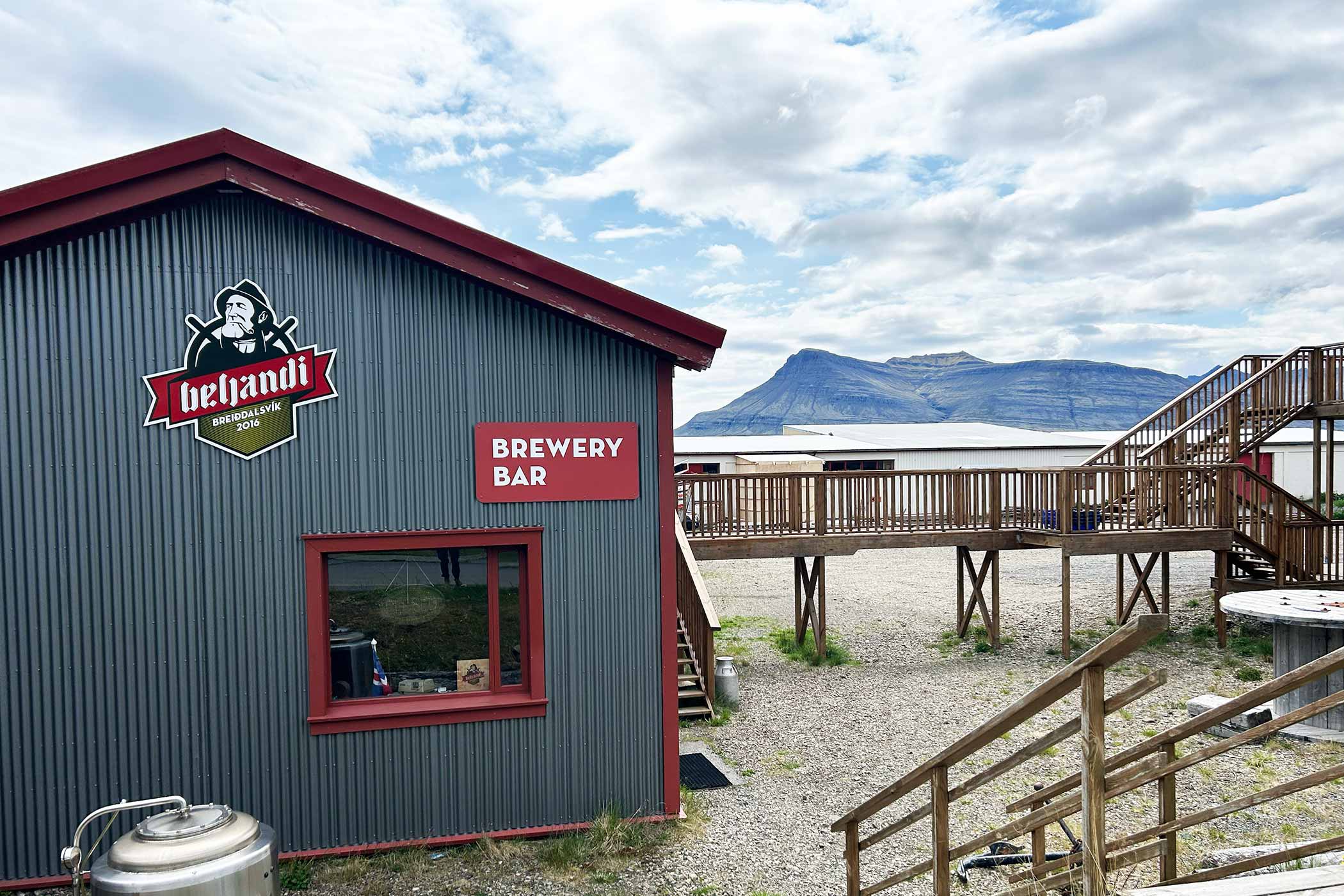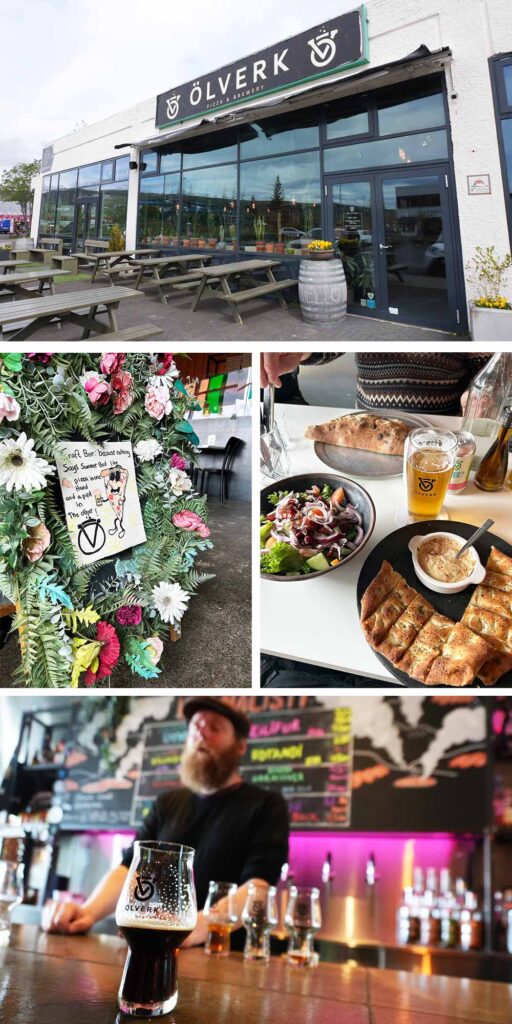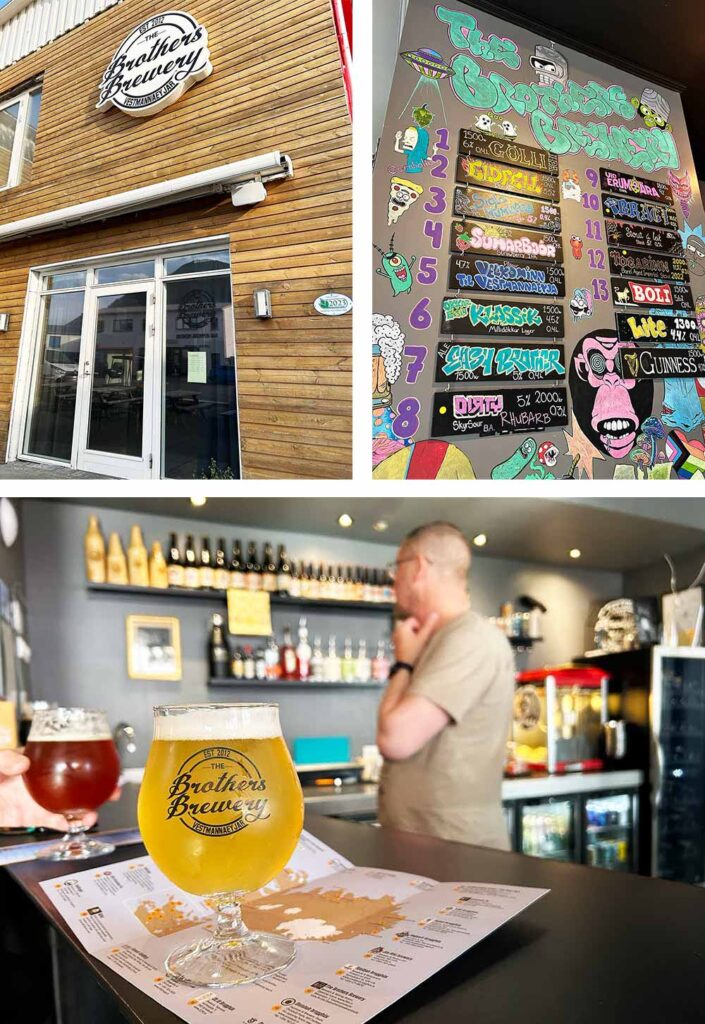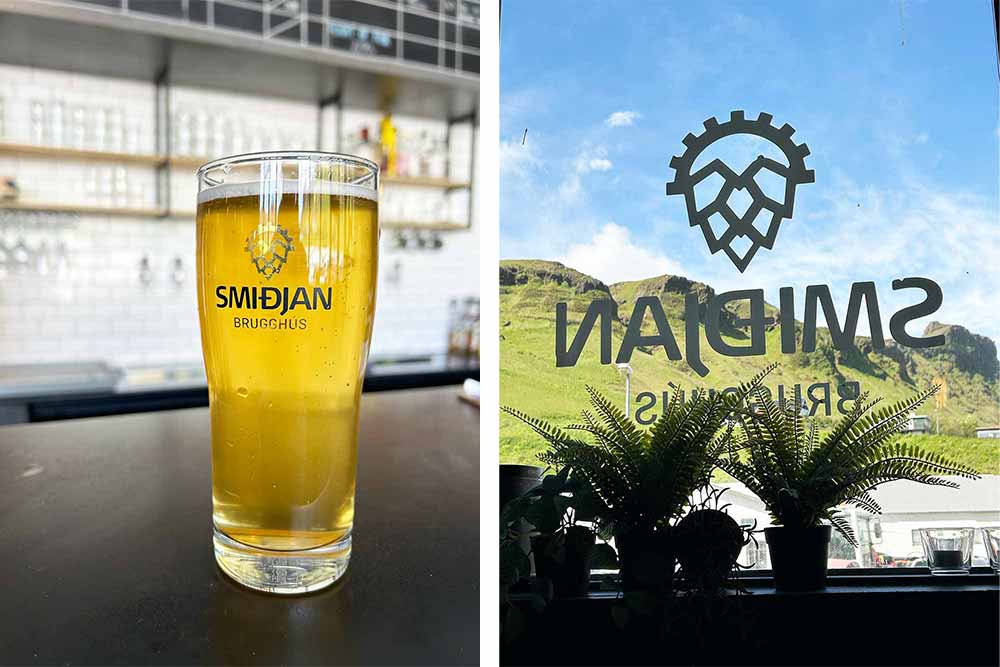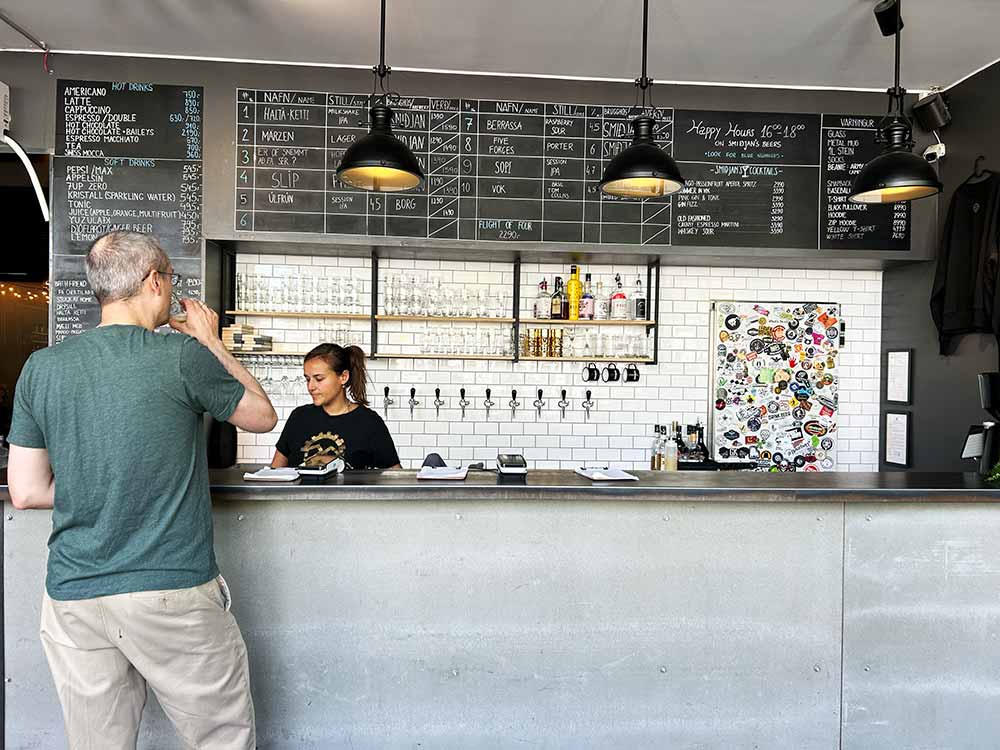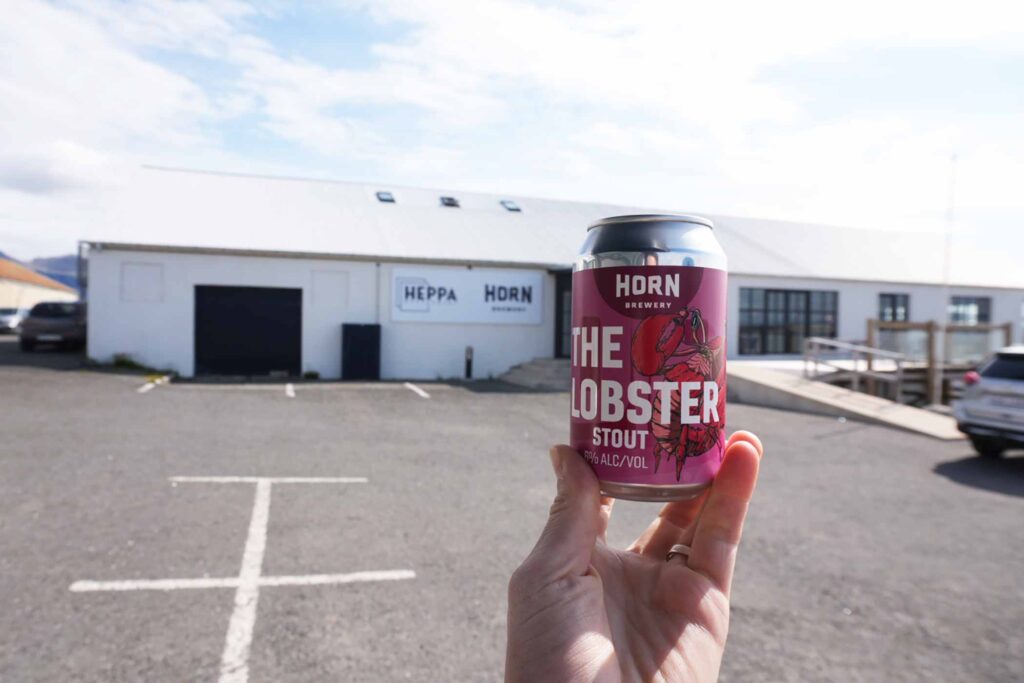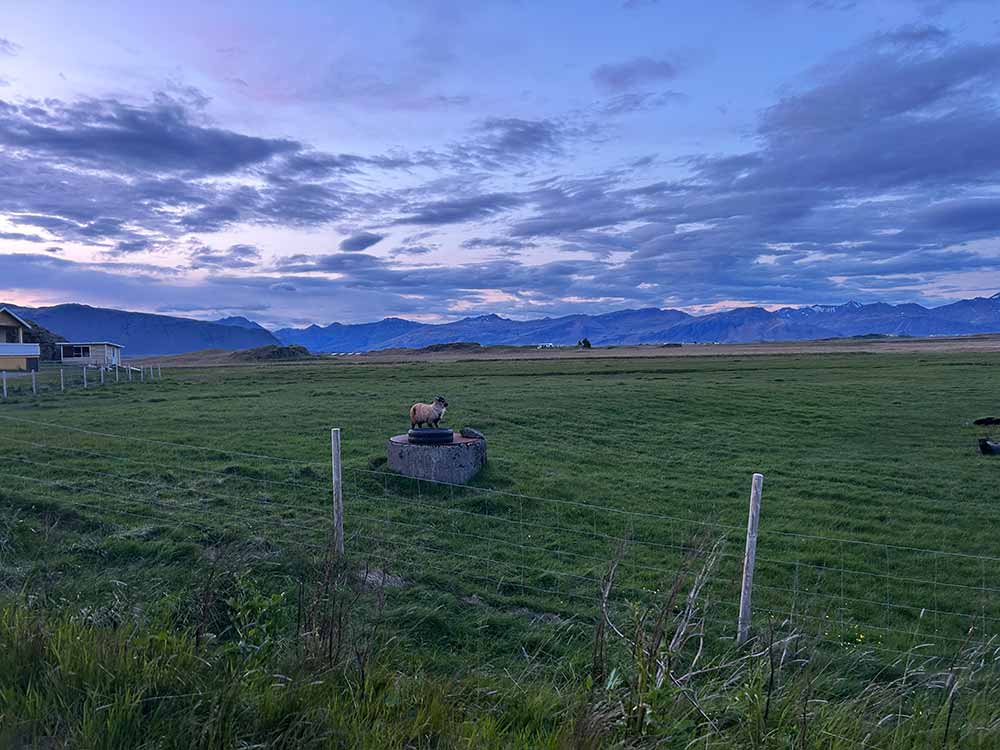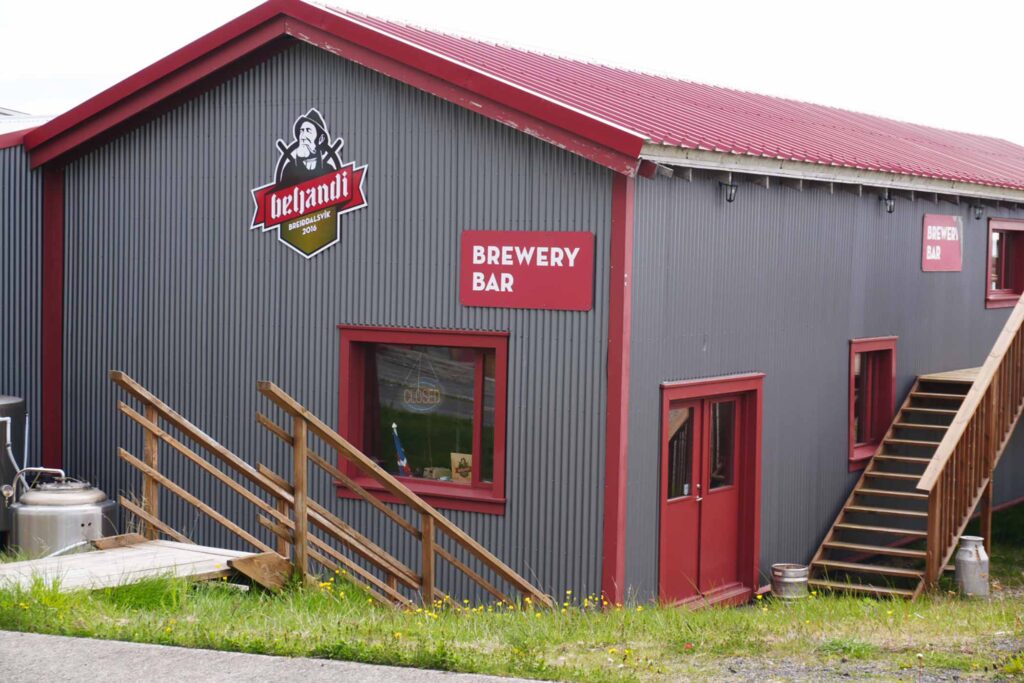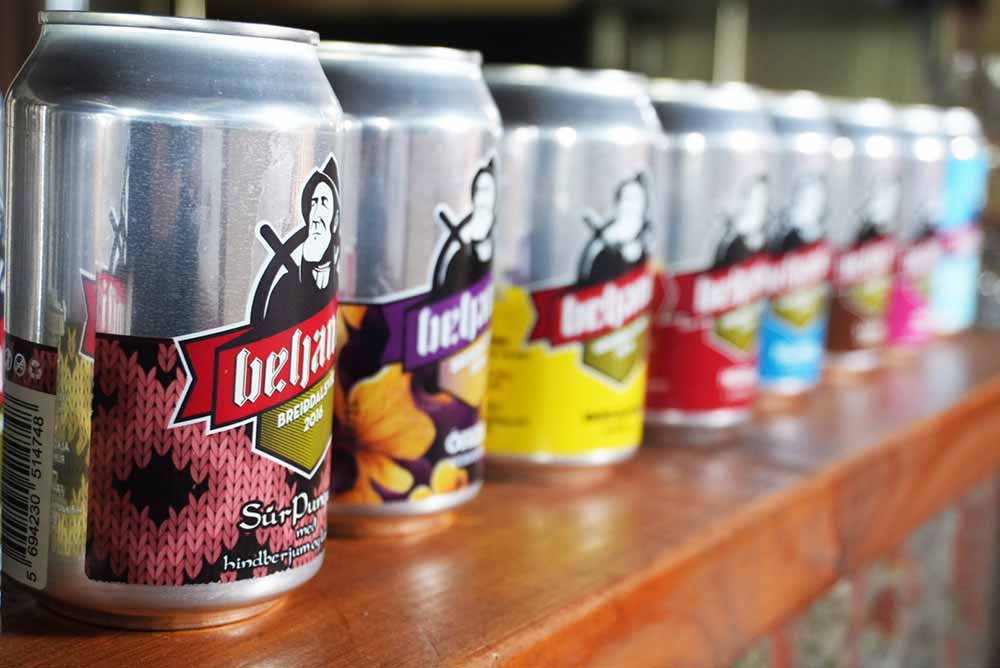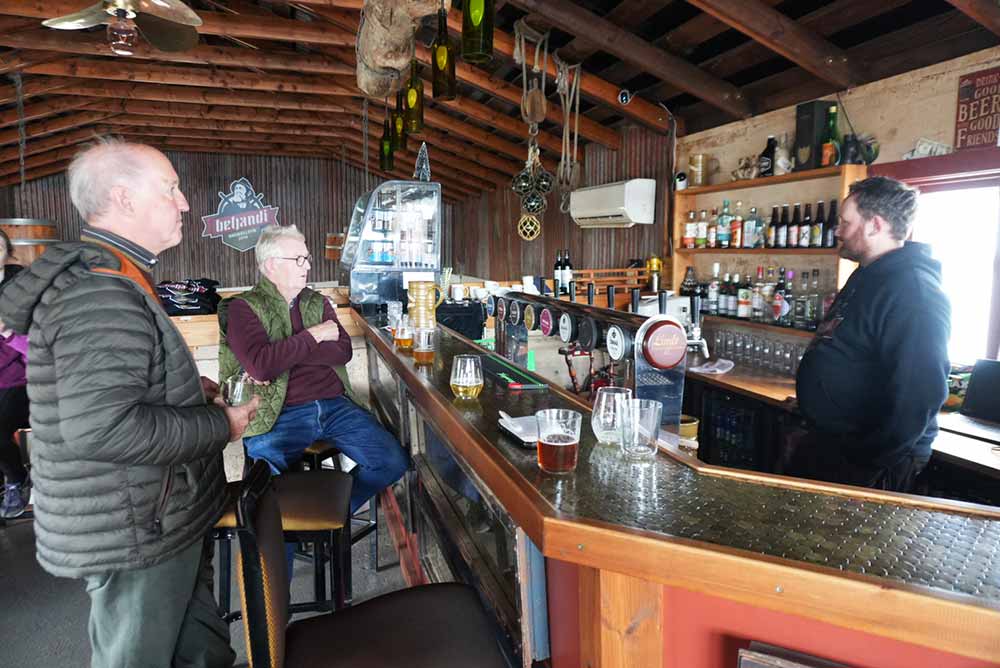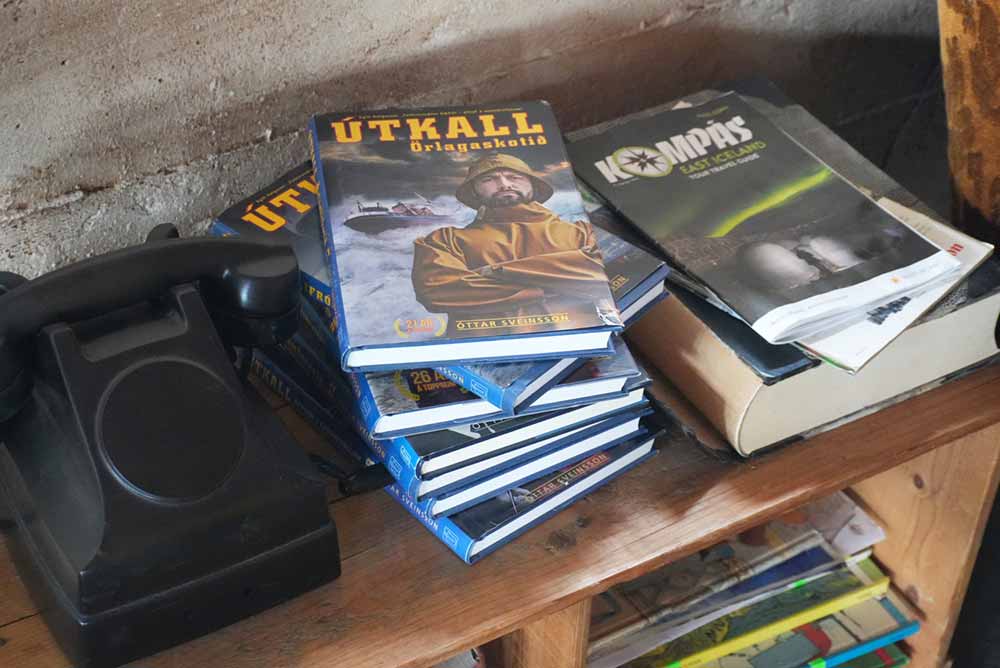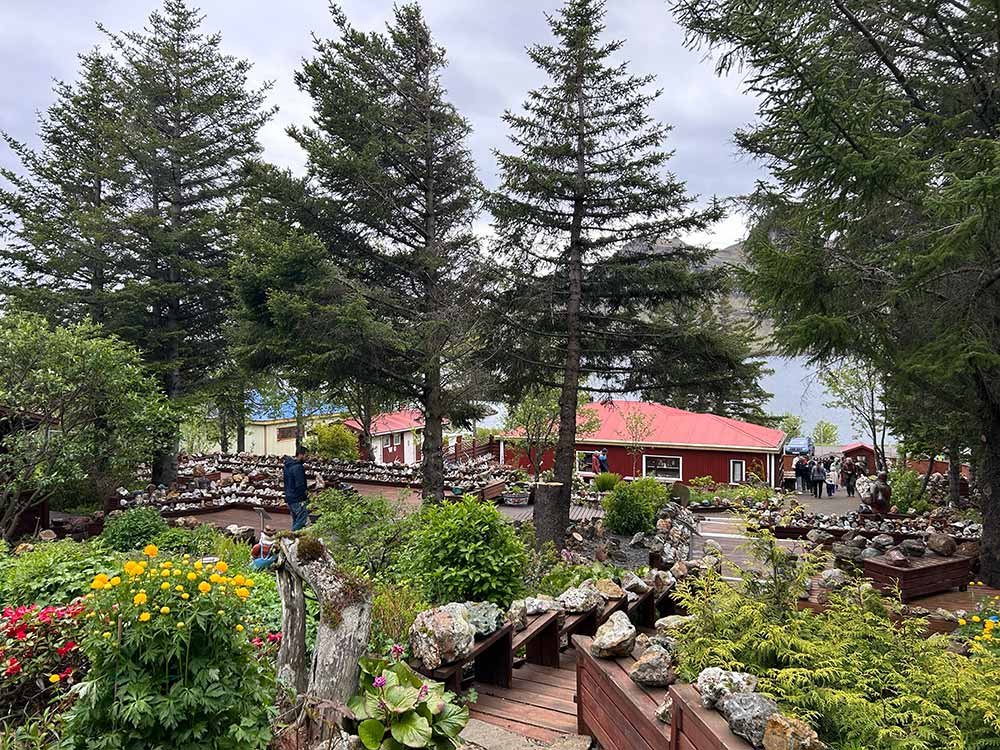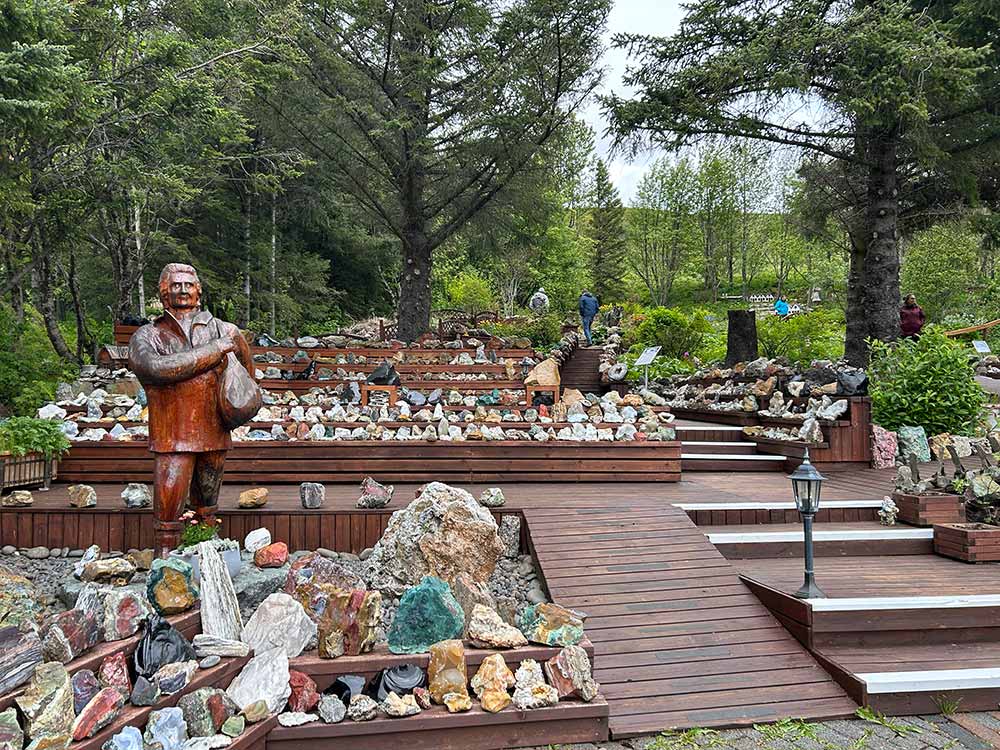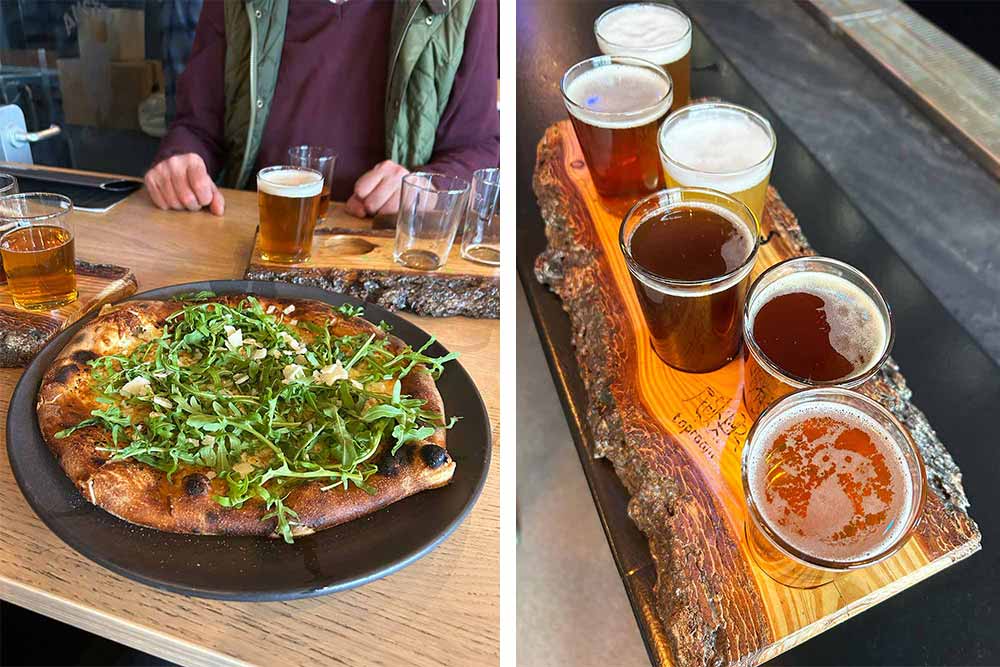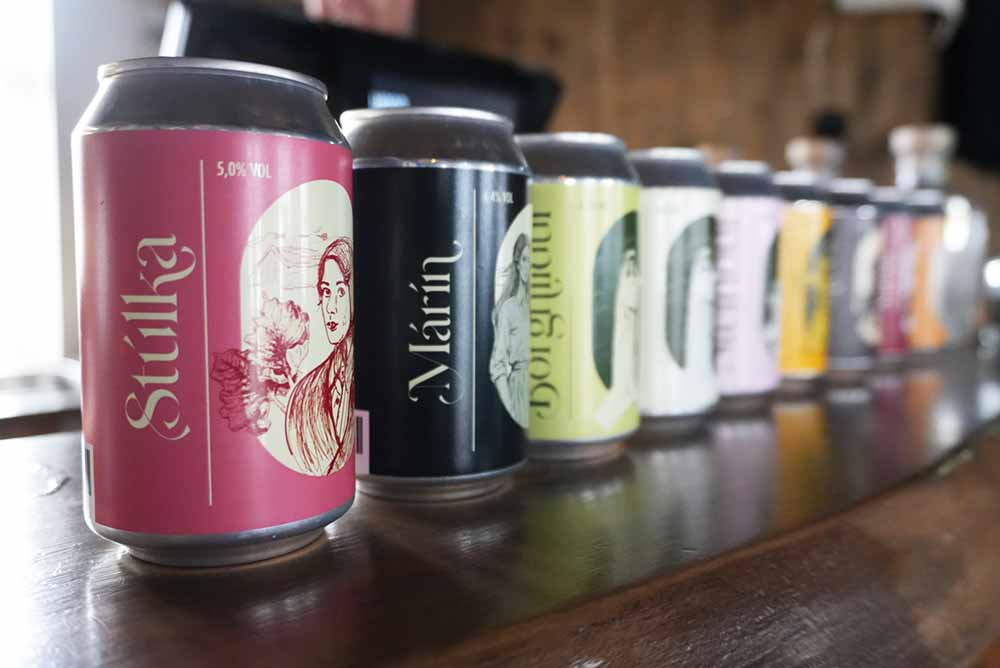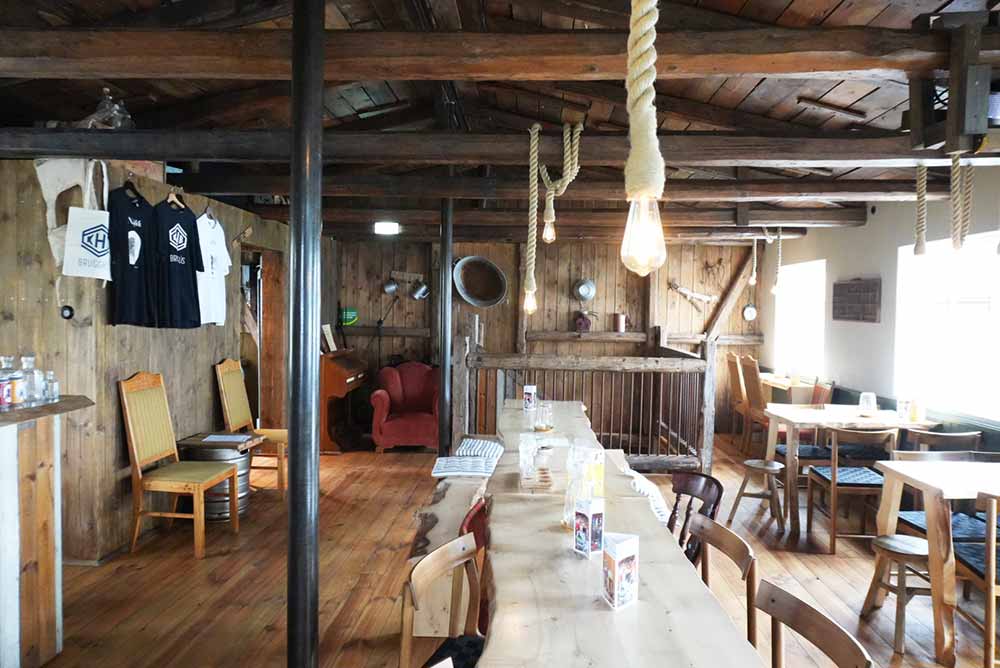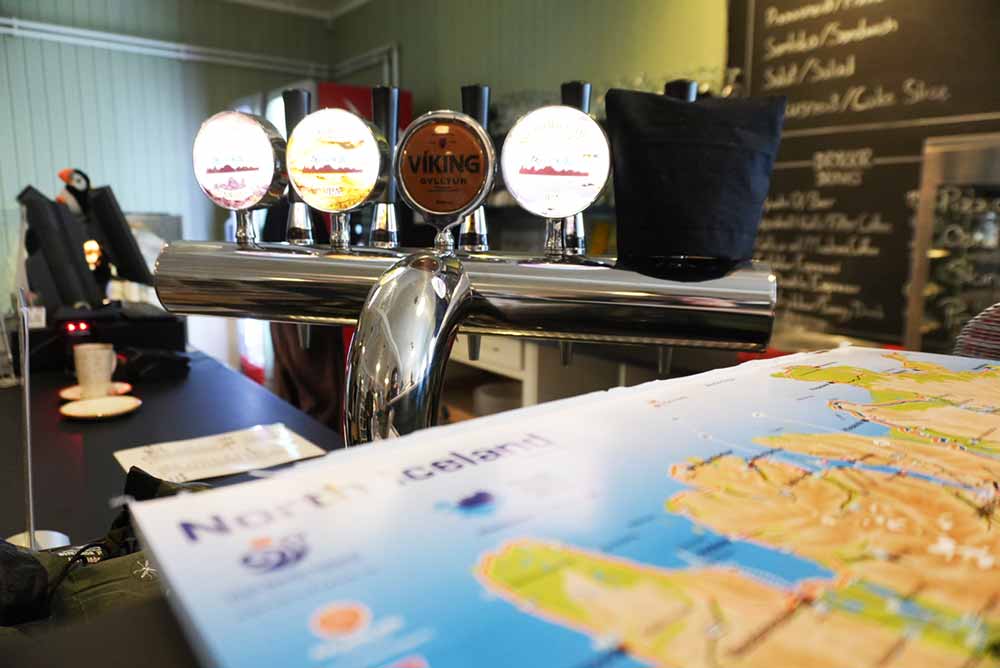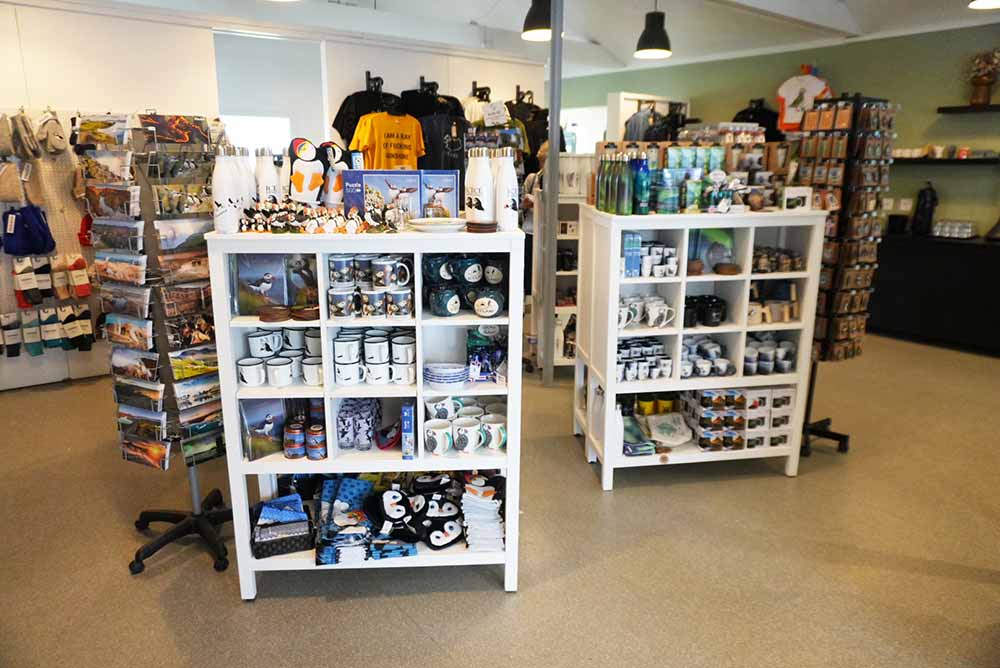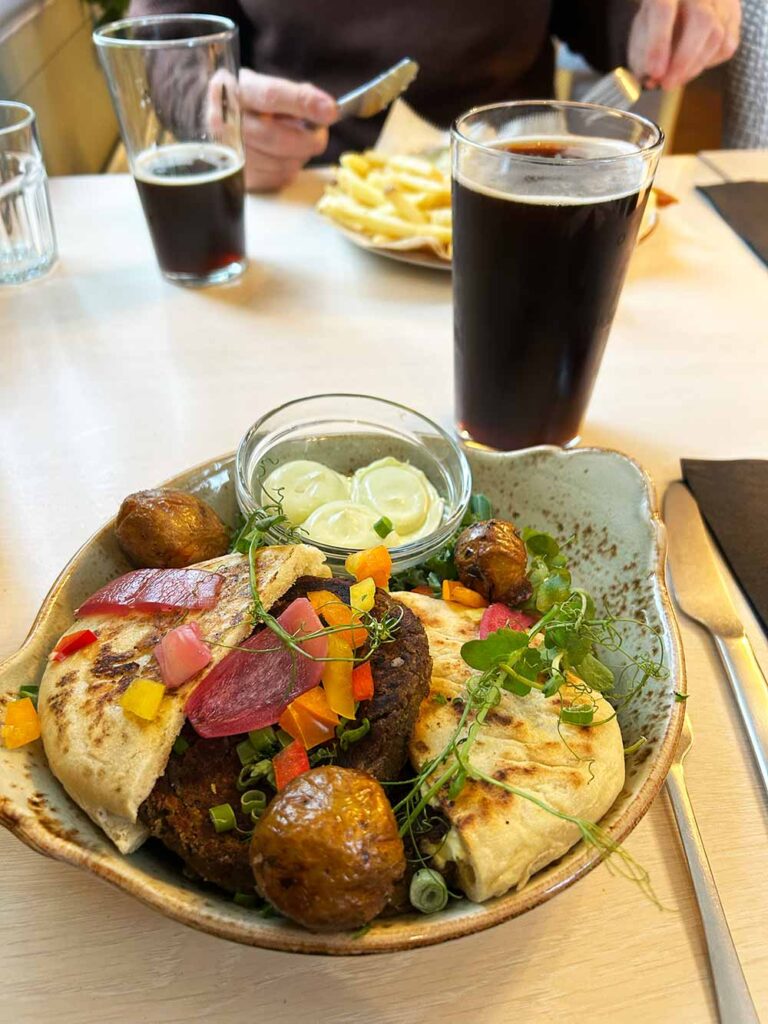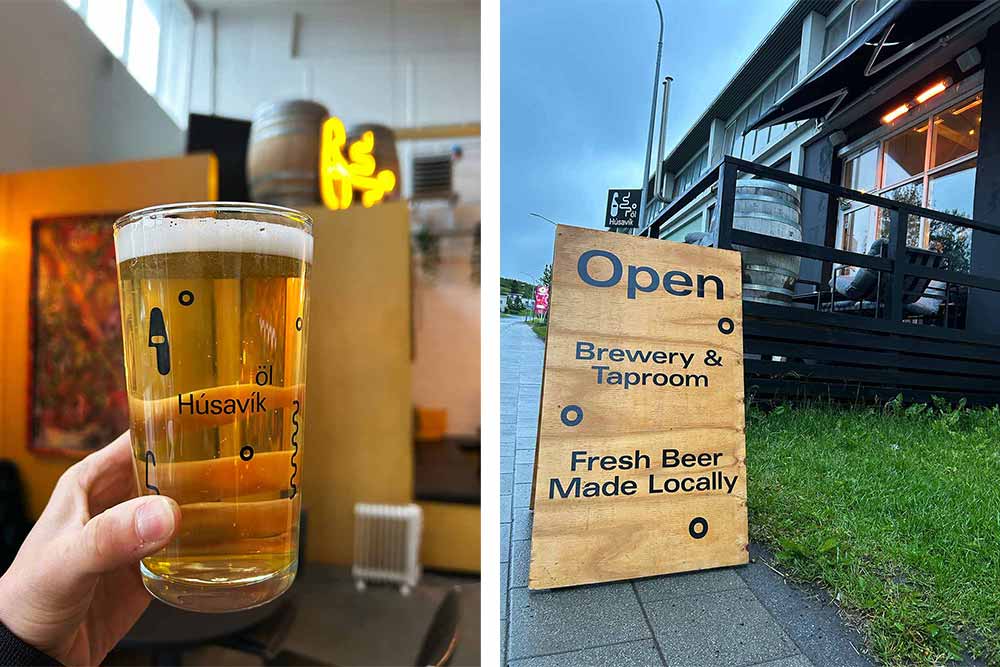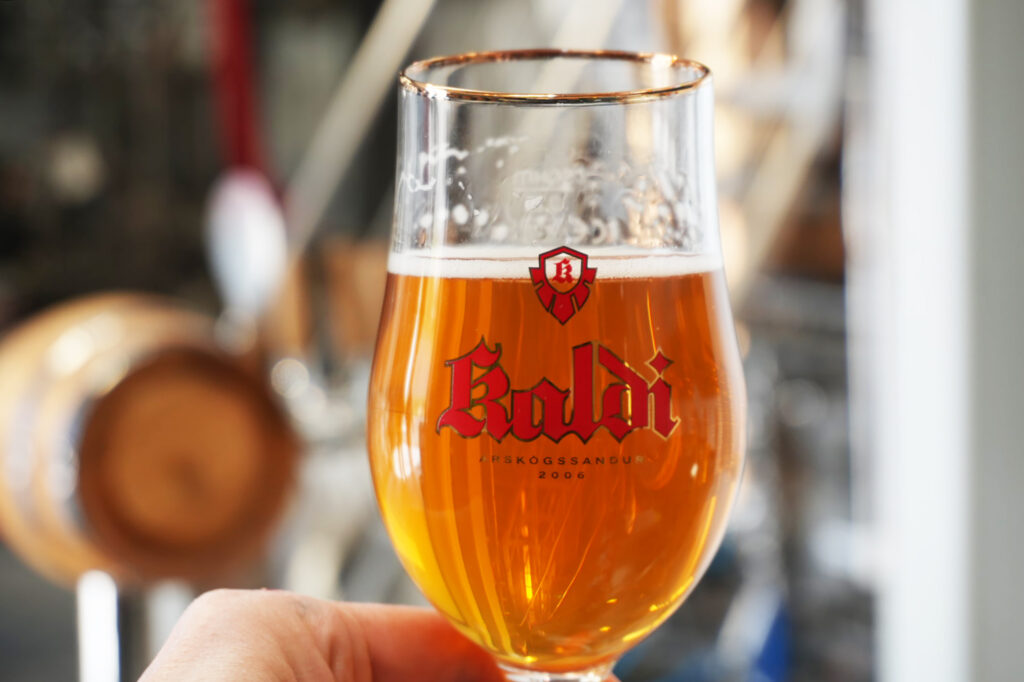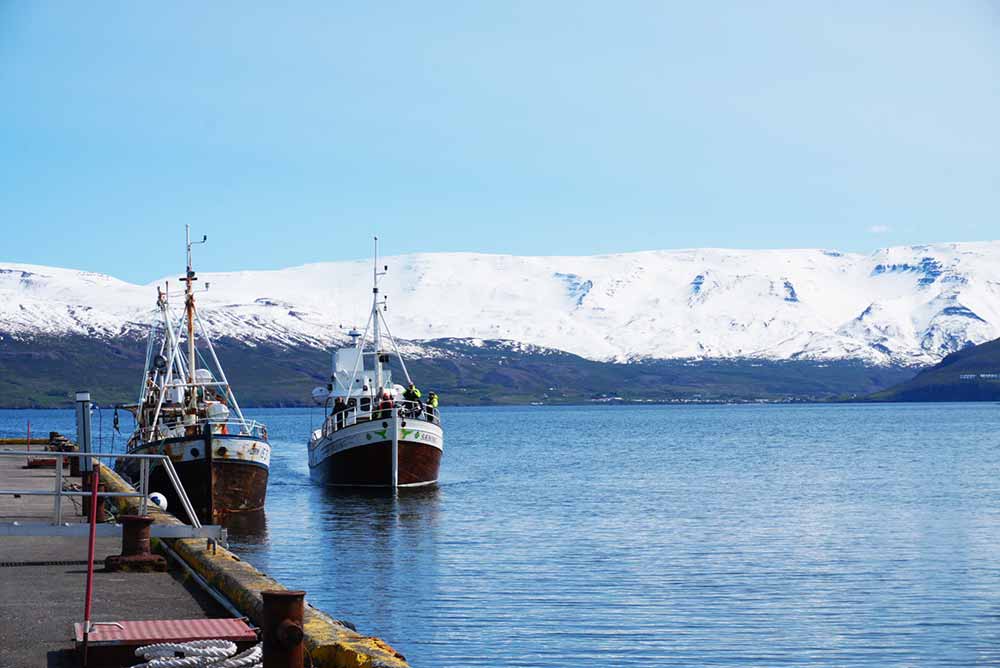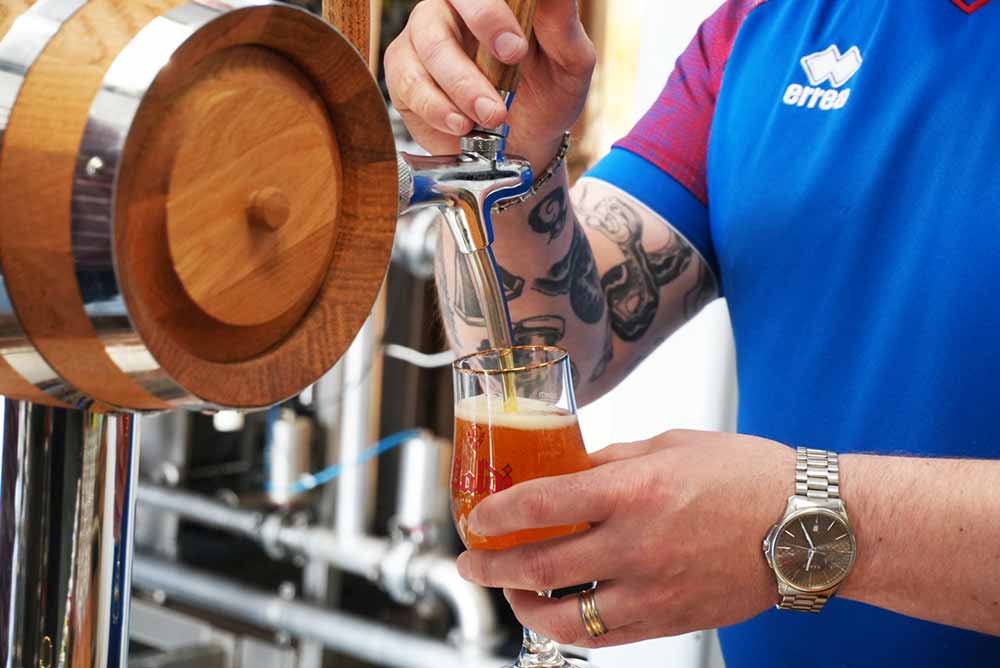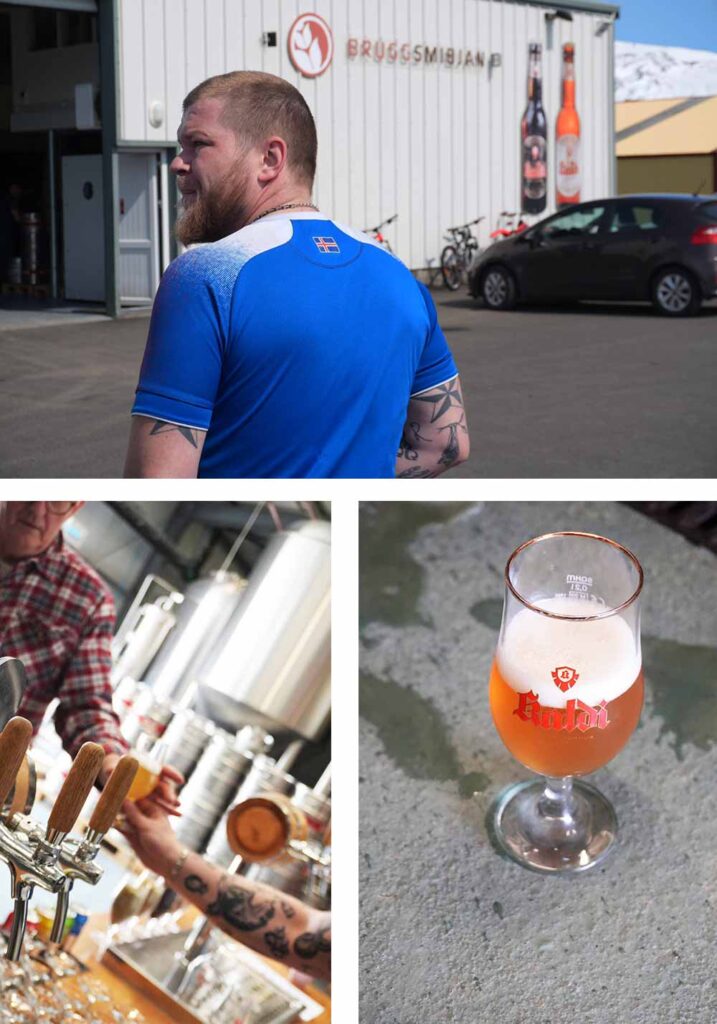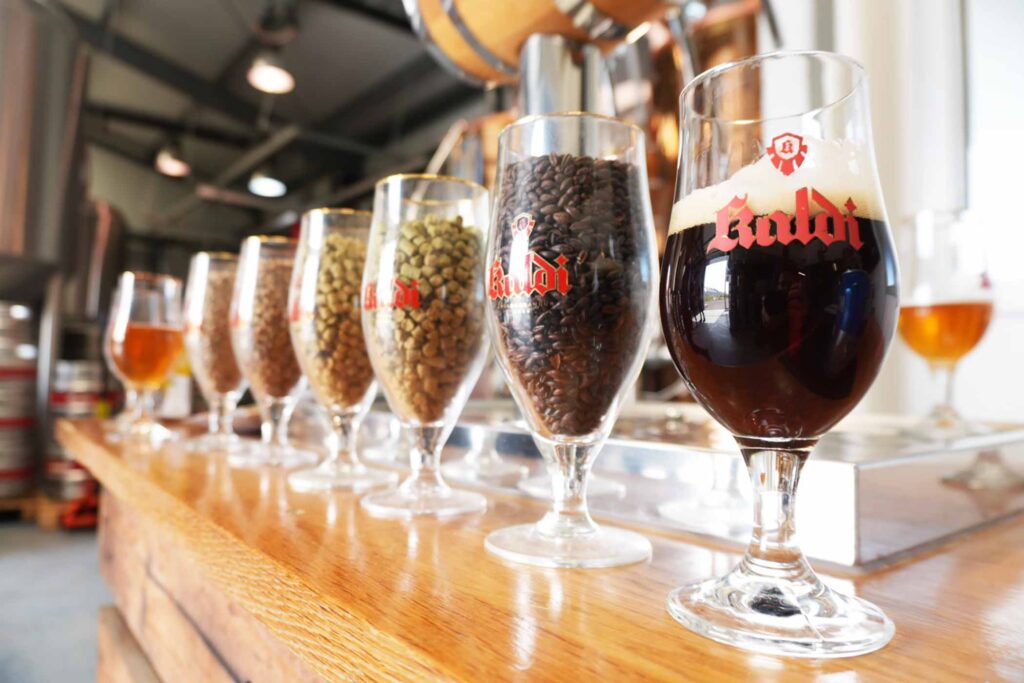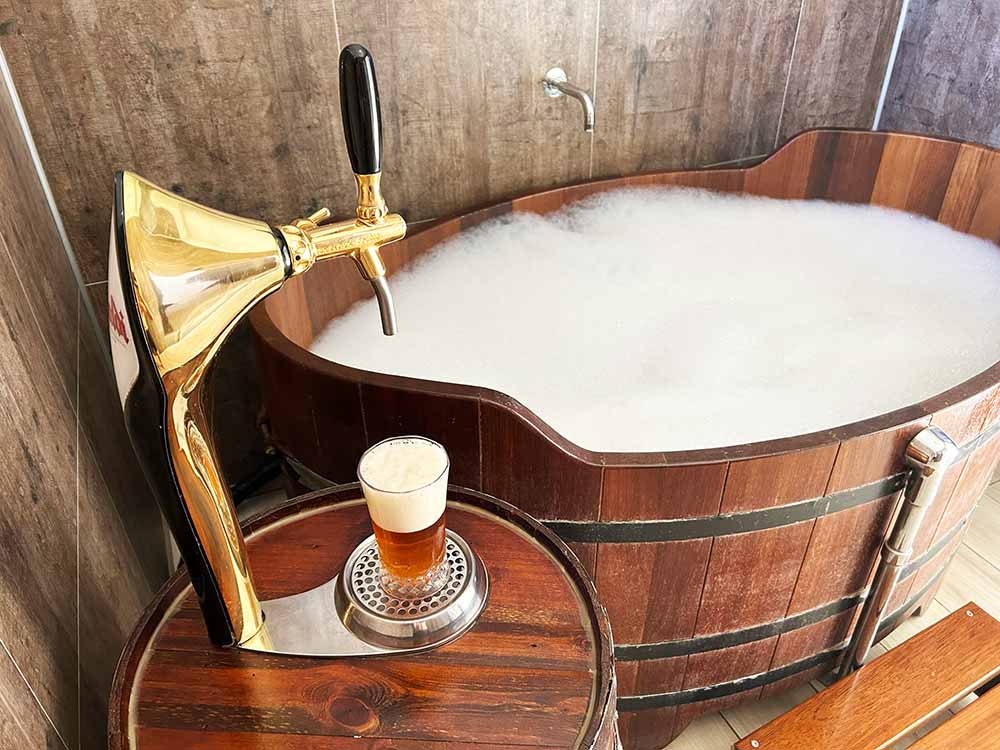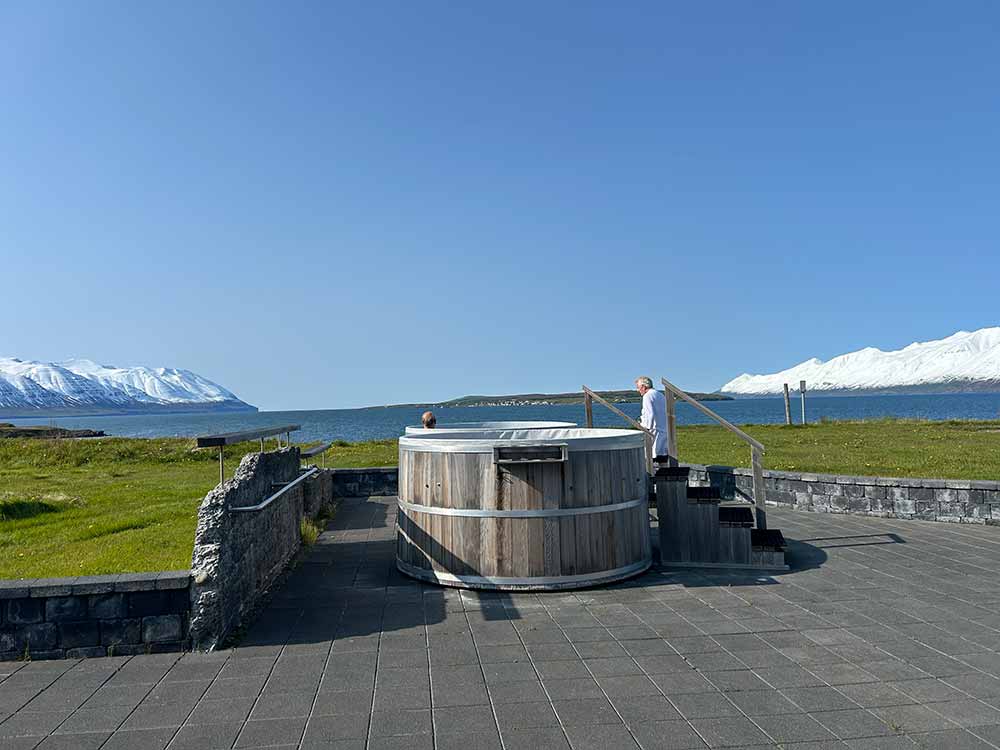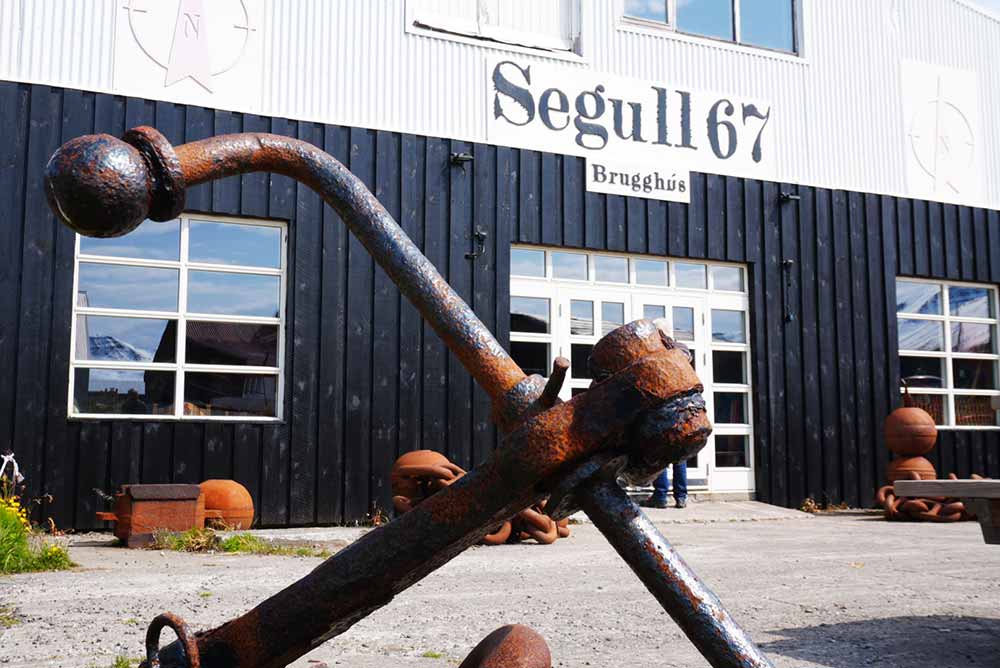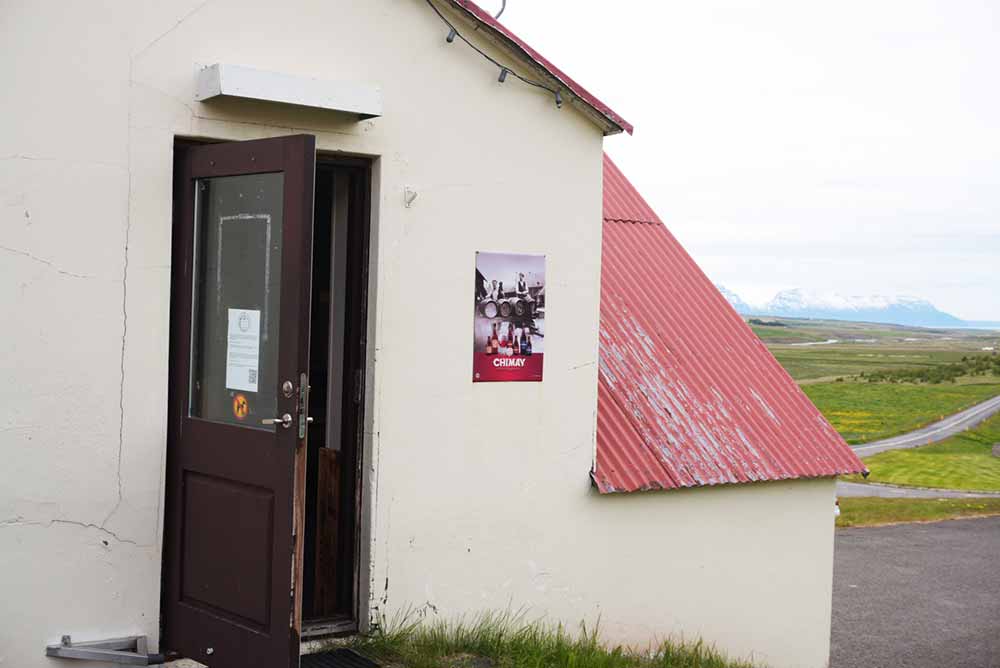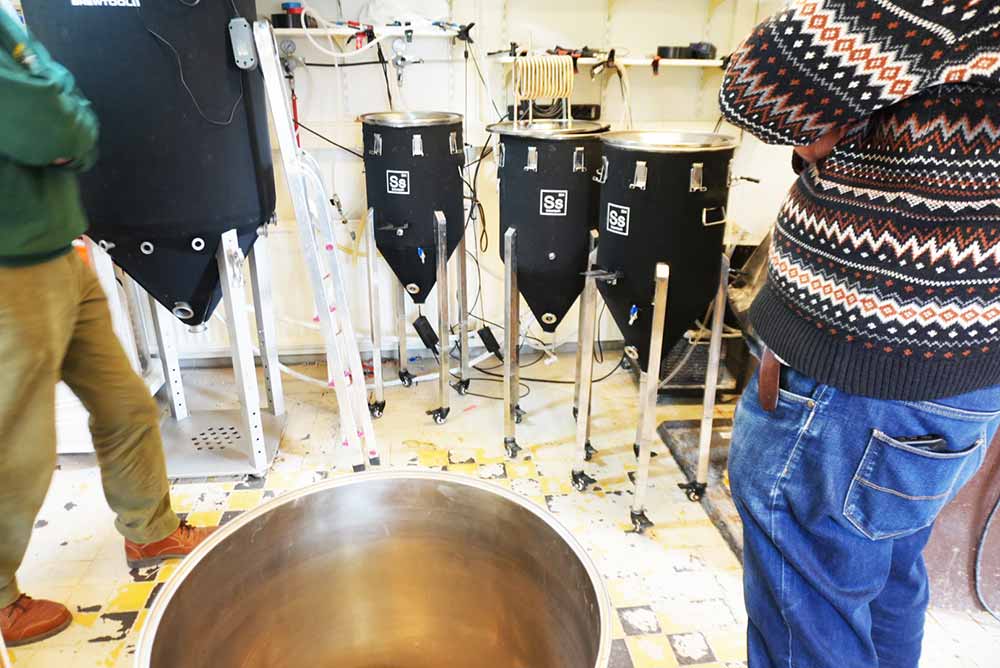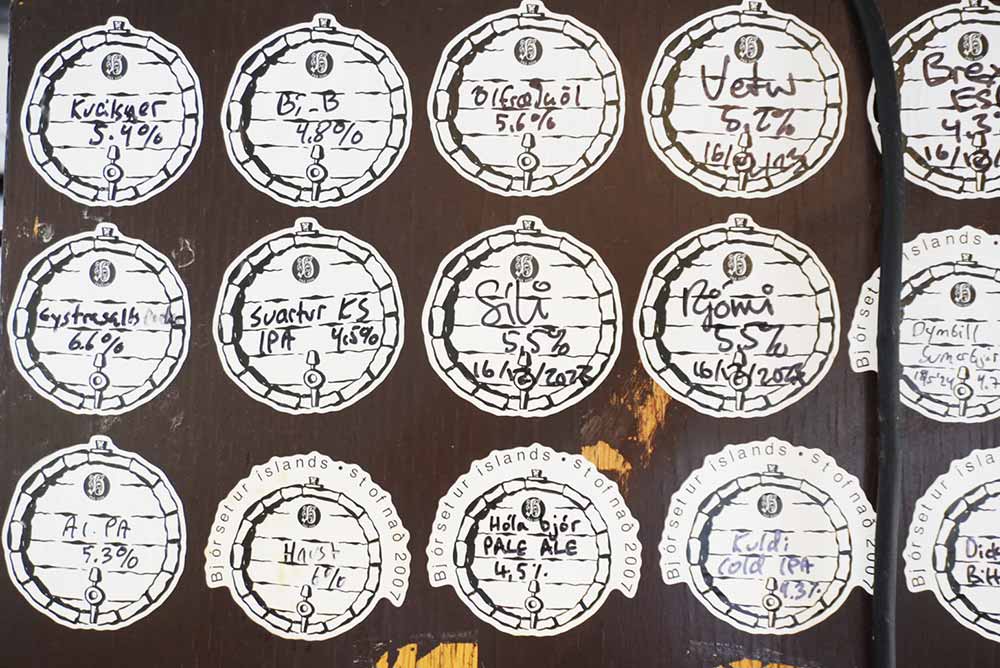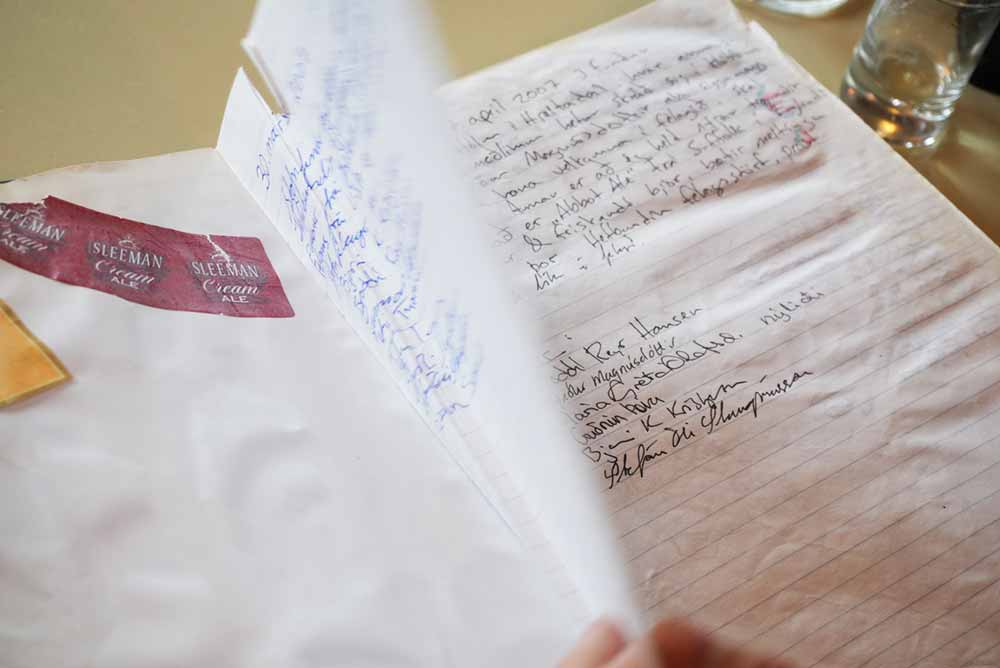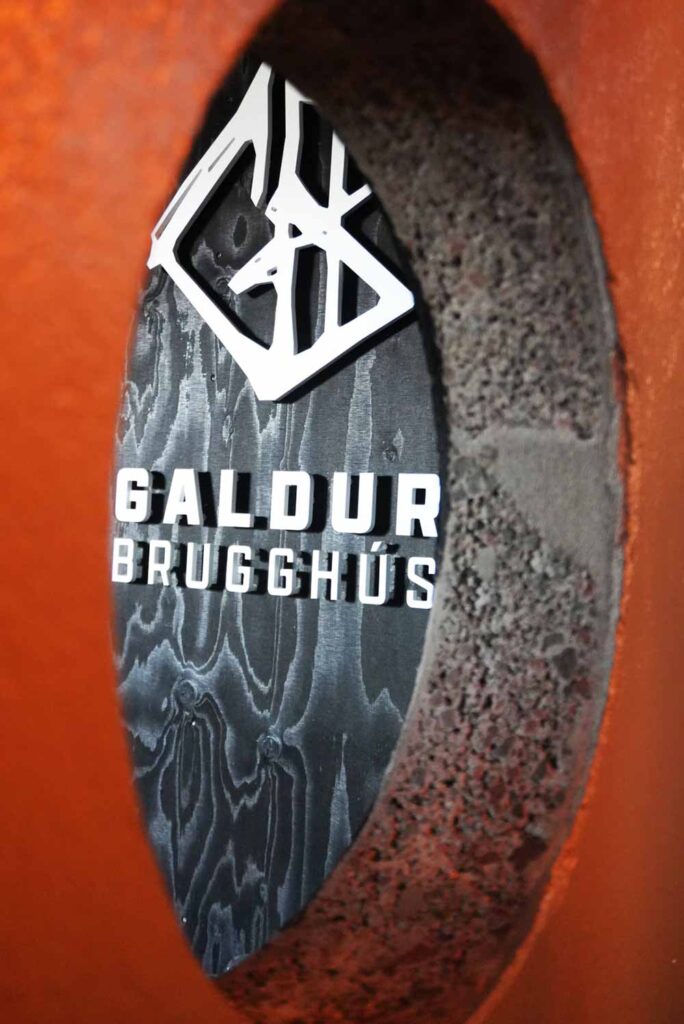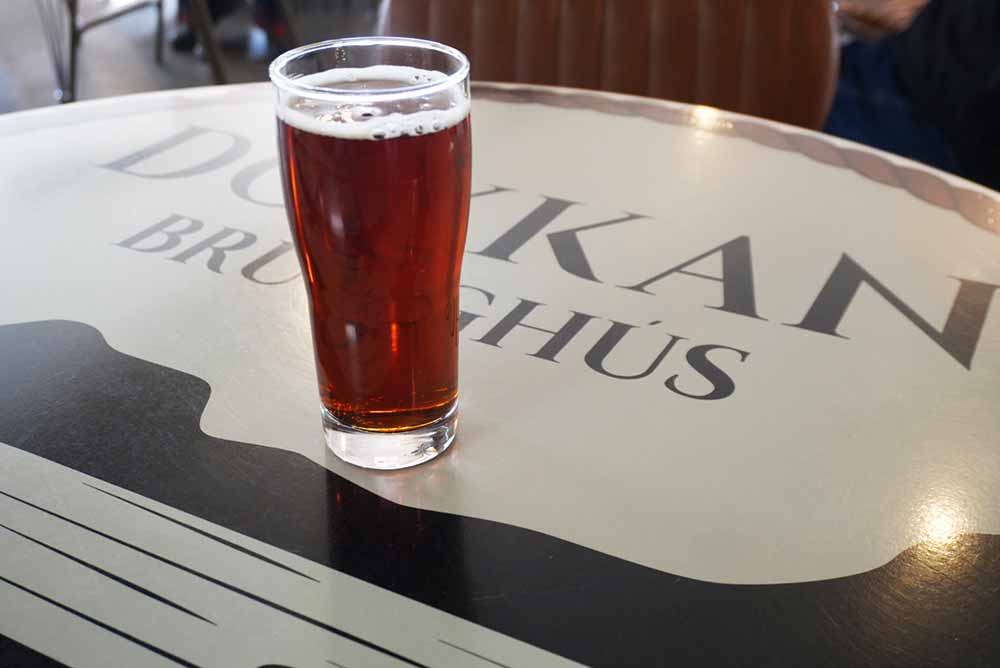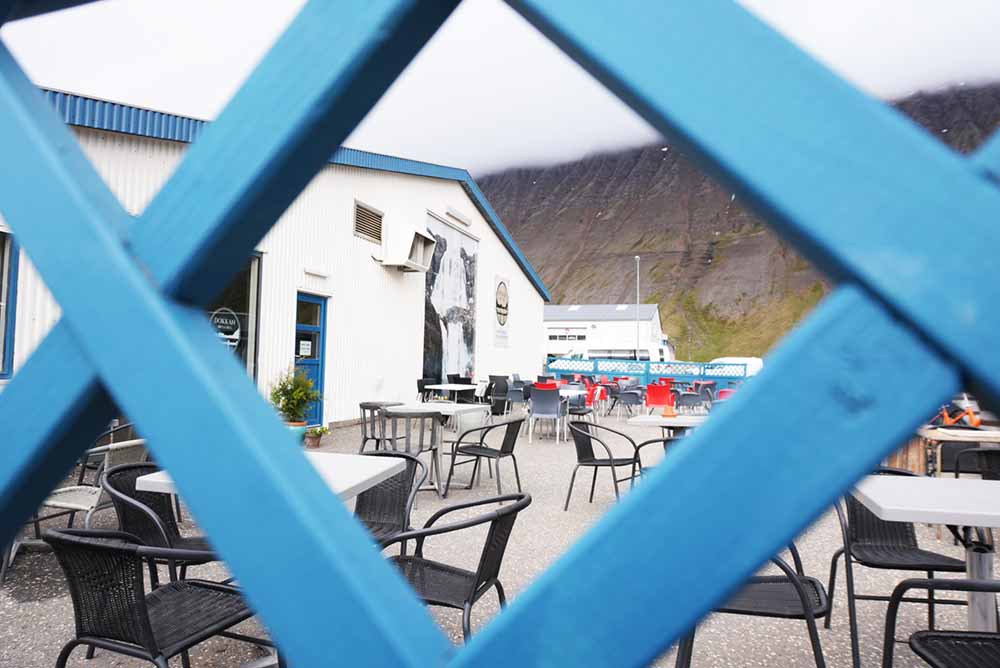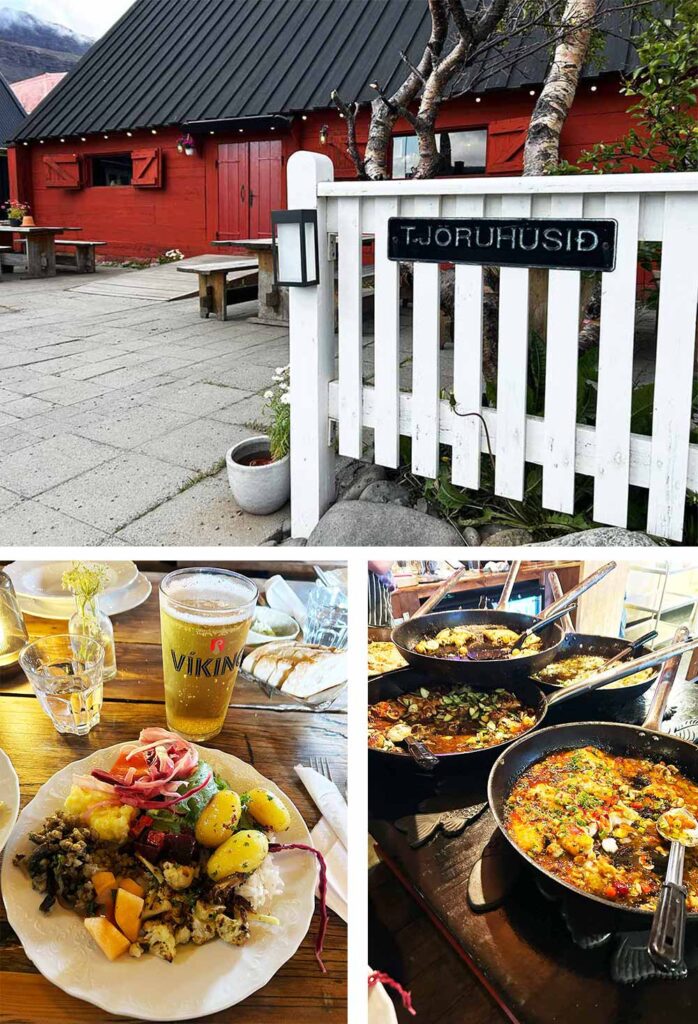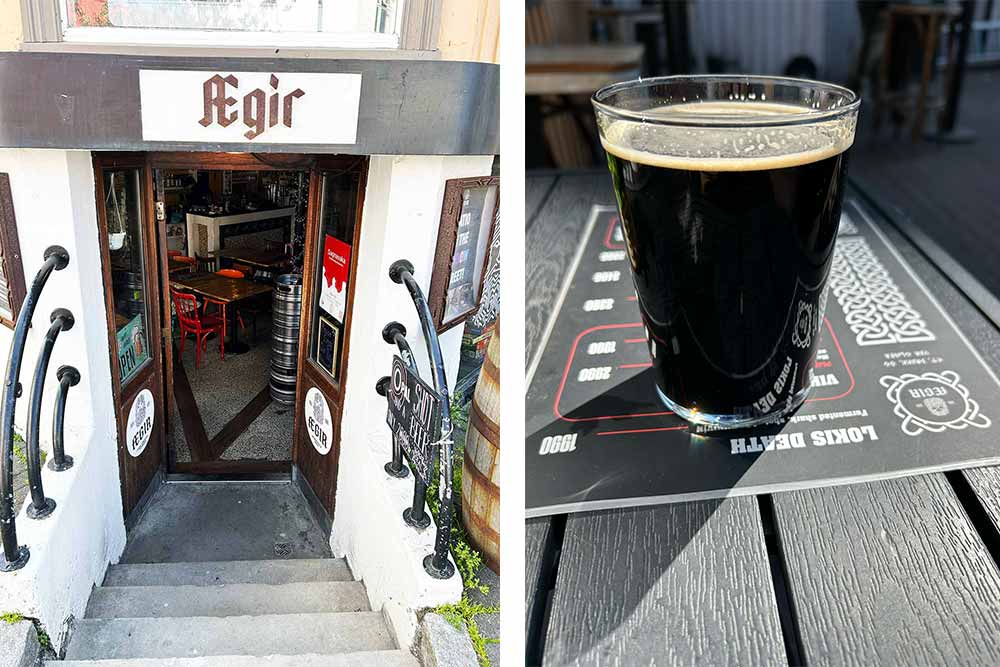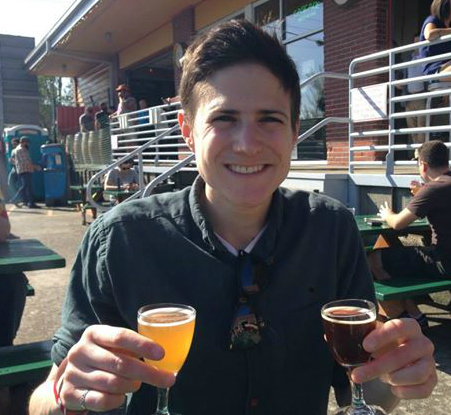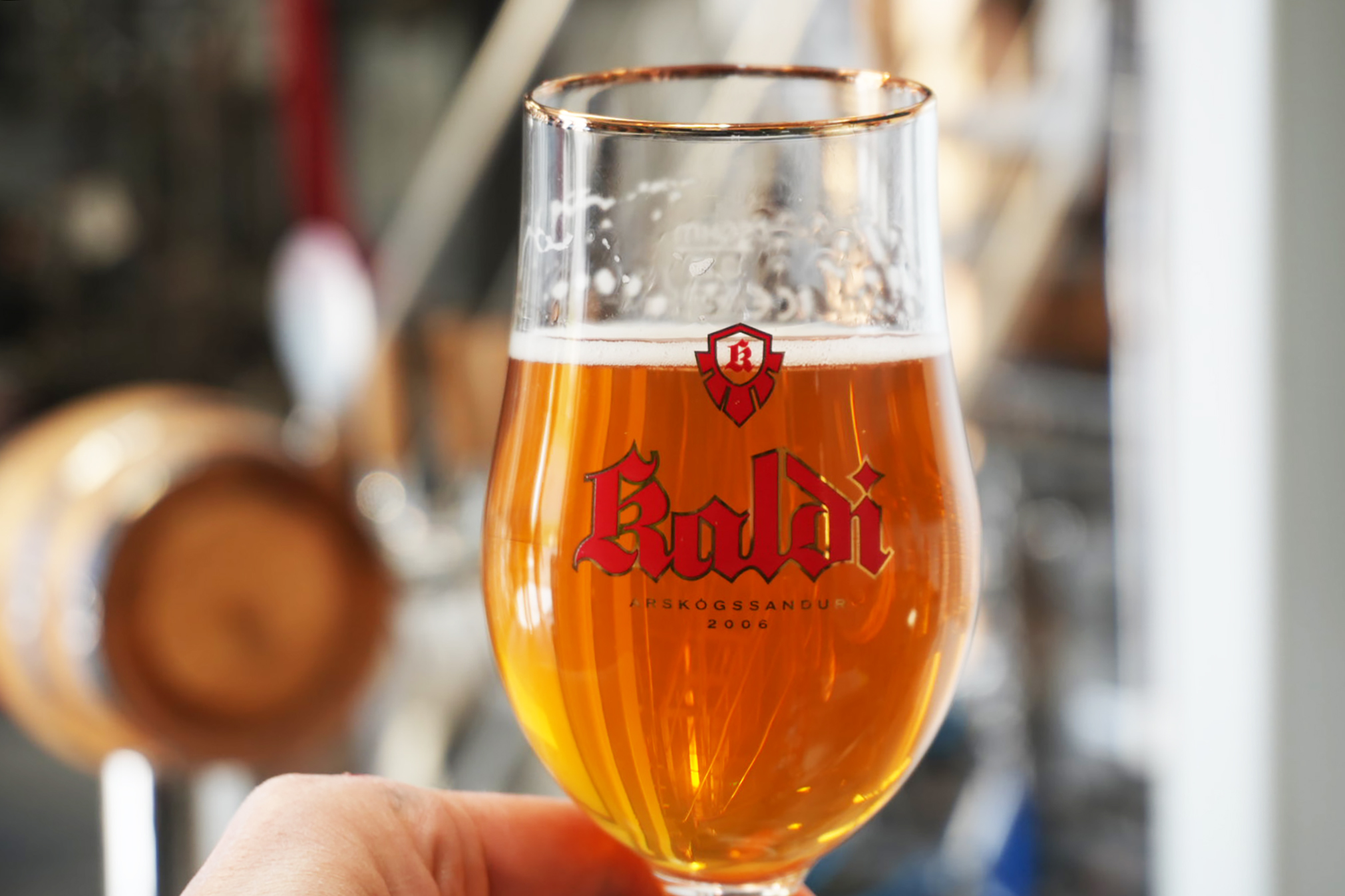Shop
How to Visit All the Breweries on Iceland’s Ring Road
Waterfalls, sheep, and beer.
Like This, Read That
I haven’t seen the night sky or a sunset in nine days. For that matter, I haven’t seen a sunrise. Each cloudy day blurs into the next on the back of a vaguely circular outline in the sky, like someone has turned a flashlight on underneath a sheet, preparing to tell a ghost story.
In the cramped quarters of our small four-seater Suzuki Vitara, which, as my driving mate has told me, should be parked at a certain angle when windy for fear of tipping over, we stare out at an ever-shifting landscape.
One day we appear to drive through the moon—all black pebbles and craters (our other passenger tells me astronauts actually train here)—another day we encounter slushy roads with wind gullies that threaten to make good on that warning. On yet another day, we keep mountains company, where streams slip into waterfalls which plunge into fjords.
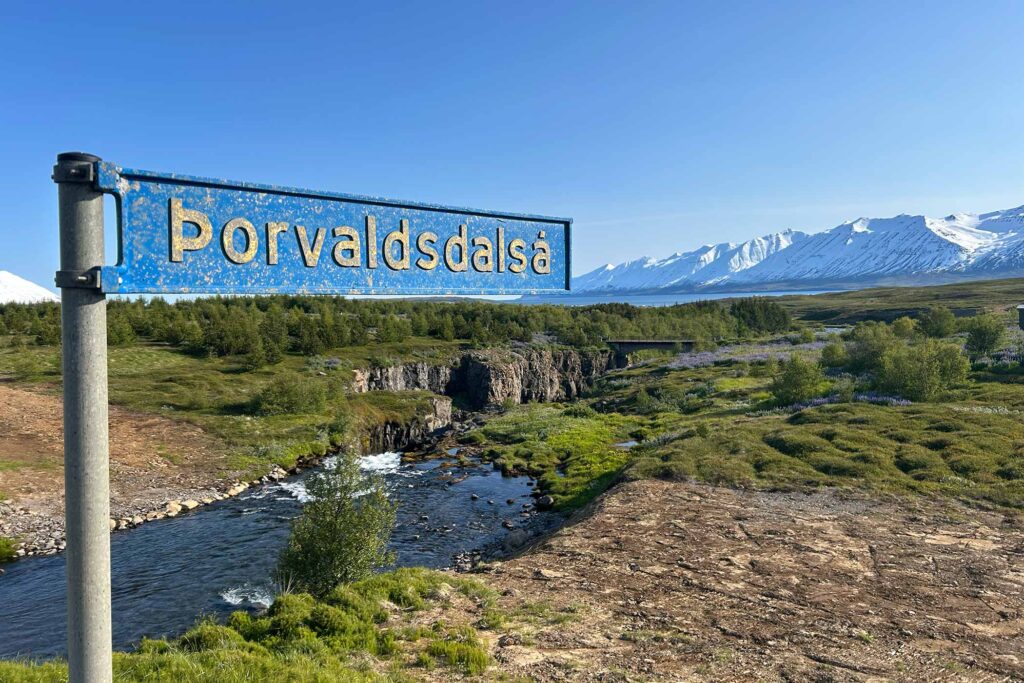
Photography courtesy of Grace Lee-Weitz | Hop Culture
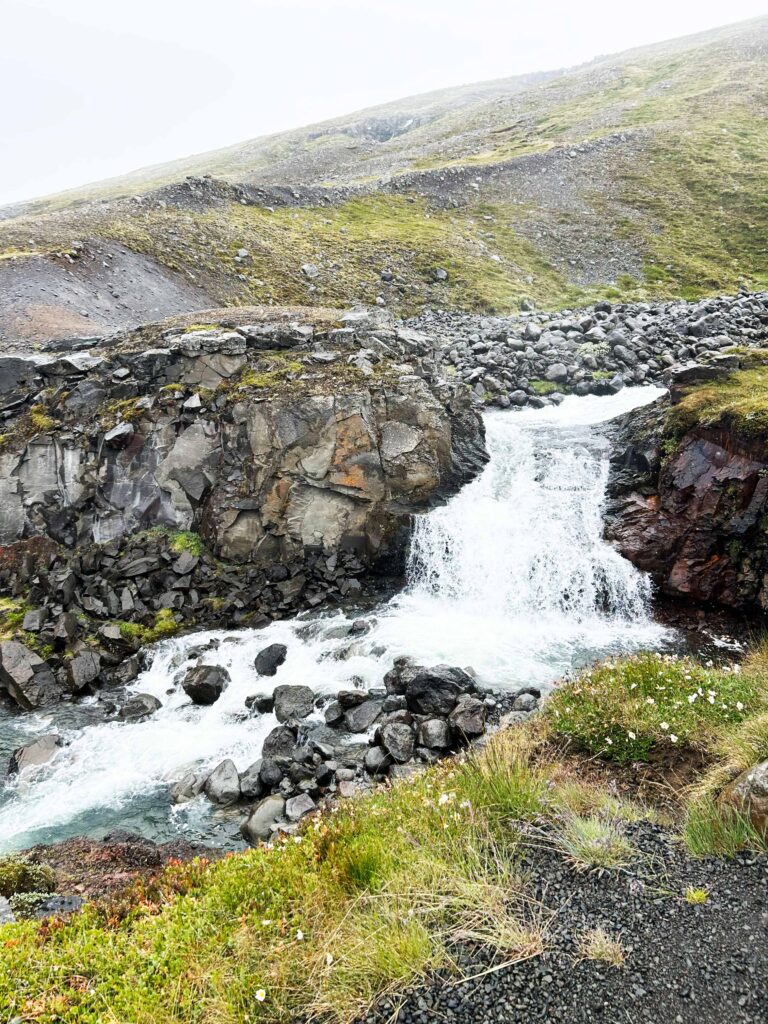
Photography courtesy of Grace Lee-Weitz | Hop Culture
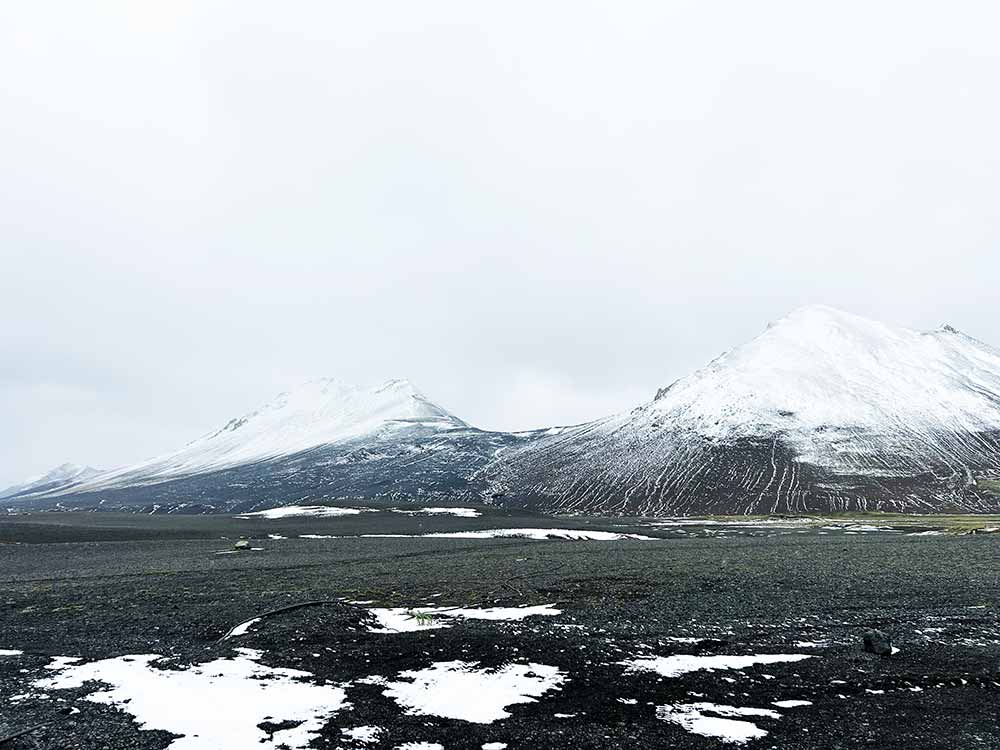
Photography courtesy of Grace Lee-Weitz | Hop Culture
You can go a steady 90kph but no more than 96kph, my companion and famous beer author, Tim Webb, tells me from the passenger seat.
We’re driving the entire length of Iceland’s Ring Road, which wraps around the circumference of the island country.
This is unlike any other trip I’ve undertaken at Hop Culture. How many people can say they’ve been to almost every single brewery in one country?
And how many people can say they made that trip with one of the most interesting people in the beer world?
Webb wrote, among other things, The World Atlas of Beer along with the Good Beer Guide Belgium. The former, my friends gifted to me when I first started working in craft beer. So when he reached out about this trip, I knew I had to go.
Why wouldn’t I follow someone who has been to ninety-three countries? Adventuring is somewhat of a tradition in his family, where his daughter competes with him to collect countries, and his grandmother once said she’s been to over 90 (although, as he tells me from the passenger seat on our first day together, she’s walked that back to 78).
He’s been to every country in Europe except for Belarus (tough now) and Moldova. He counts some of his favorite countries as Costa Rica (where he saw a 360-degree rainbow in a small four-seater plane before the scariest plane ride of his life), South Africa, and Belgium.
When I ask him what’s still on his bucket list, the postage stamp collector replies that his aren’t standard. He wants to drive from Perth to Adelaide just because, supposedly, the GPS tells you that the next turn will be in 2,693km (~1673 miles). He’s always wanted to see all the sheep on the Faroe Islands—apparently, there are close to thirty kinds, with a guide published by the area for avid sheep watchers. And he wants to drive the longest-span bridge in France to add to those he’s already driven in Key West and Prince Edward Island.
And he hopes to one day stay in the Commodore suite on a boat he rode as a kid, enjoying a seven-course meal by himself because everyone else was so sea sick that the servers had to take turns serving him.
He’s a man who has collected stories like pictures in a photo album. After a bit of caffeine, which he admits makes his brain whir, or a good IPA or Czech pale lager, his tongue loosens and the words come pouring out like alphabet soup from a can.
When he walks, he shuffles, when he speaks, he mumbles, and when he drinks, he tells stories. Lots and lots of stories. He has an uncanny storytelling knack, often lapsing into accents to recount adventures in far-flung places.
With beer, high praise from him isn’t extravagant exclamations. When he says, “I can’t find any flaws with a beer,” I come to understand that means he really likes it.
I learn all of this over our nine days together. Because when you take turns driving over 800 miles (~1,300 km) and stop at one to three breweries a day, you get to talking.
Together, we visited nearly every brewery in Iceland. In a country where it’s reportedly said the sheep outnumber the people (and indeed the breweries), we found a beer culture that was as warm as the Icelandic night is cold.
Brewery owners opened their doors to us—many in small, remote places, sometimes with odd hours. Each eager to share with us and a bit perplexed even to find us on their doorstep.
But together, a famous British beer writer and adventurer, and a West Coast magazine editor, typically miles apart and far from home, found something extraordinary in a place where the sun rarely set.
We found beer. Good craft beer.
So for the first time, for this travel guide, we’re not just sharing our favorites in one place, we’re going to take you along for the entire ride.
Miles driven: 828 (1,332 km)
Breweries visited: 16*
Beers drunk in liters: Unknown (psst: a lot)
Once-in-a-lifetime trip: Priceless
*Editor’s Note: A couple of the breweries we visited do not have taprooms open to the public. While we secured private tours at them, we’re not including them here because they do not have accessible spaces for you to all enjoy!
Hop Culture’s Visit to Every Single Brewery in Iceland
Since this is a longer guide, we’re going to break things down by day, so feel free to jump right to a certain section:
-
- Getting Around and Where to Stay
- A Brief Word on Beer Trends in Iceland
- Day One: South Iceland and the Westman Islands
- Day Two: Vík, Hólmur, and Höfn
- Day Three: East Iceland: Breiðalsvík, Stöðvarfjörður, and Egilsstaðir
- Day Four: Northeast to North Iceland: Borgafjörður Eystri and Mývatn
- Day Five: North Iceland: Húsavík
- Day Six: North Iceland: Árskógssandur
- Day Seven: North Iceland: Siglufjörður, Hólar, and Sauðárkrókur
- Day Eight: Northwest Iceland: Hólmavík and Isafjörður
- Day Nine: Back to Reykjavik
Getting Around and Where to Stay
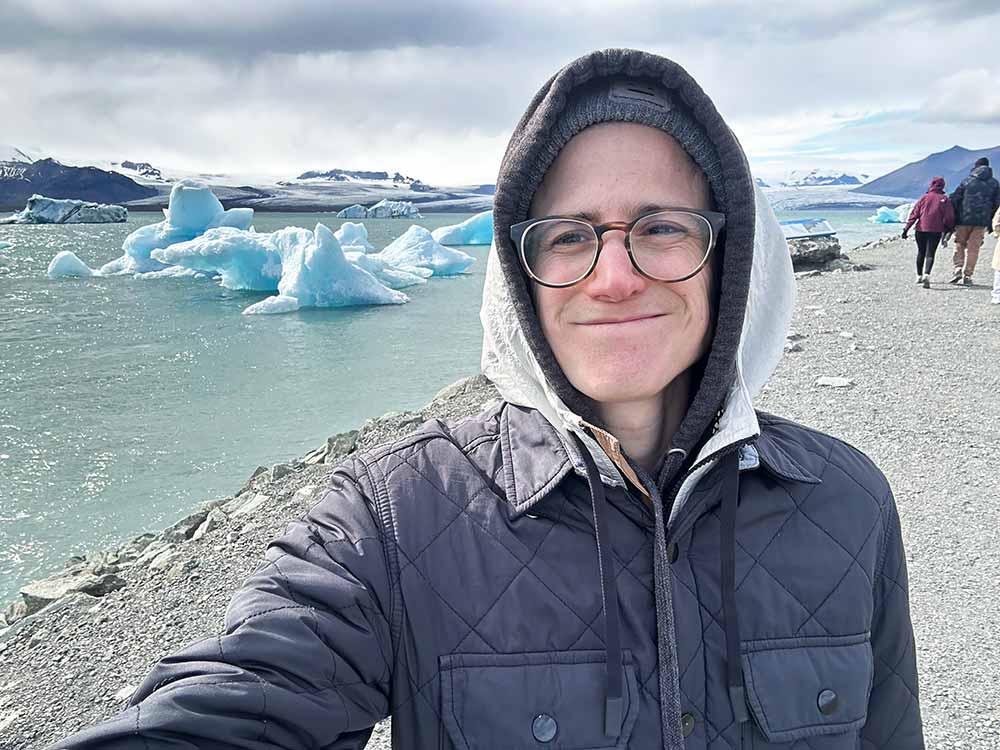
Photography courtesy of Grace Lee-Weitz | Hop Culture
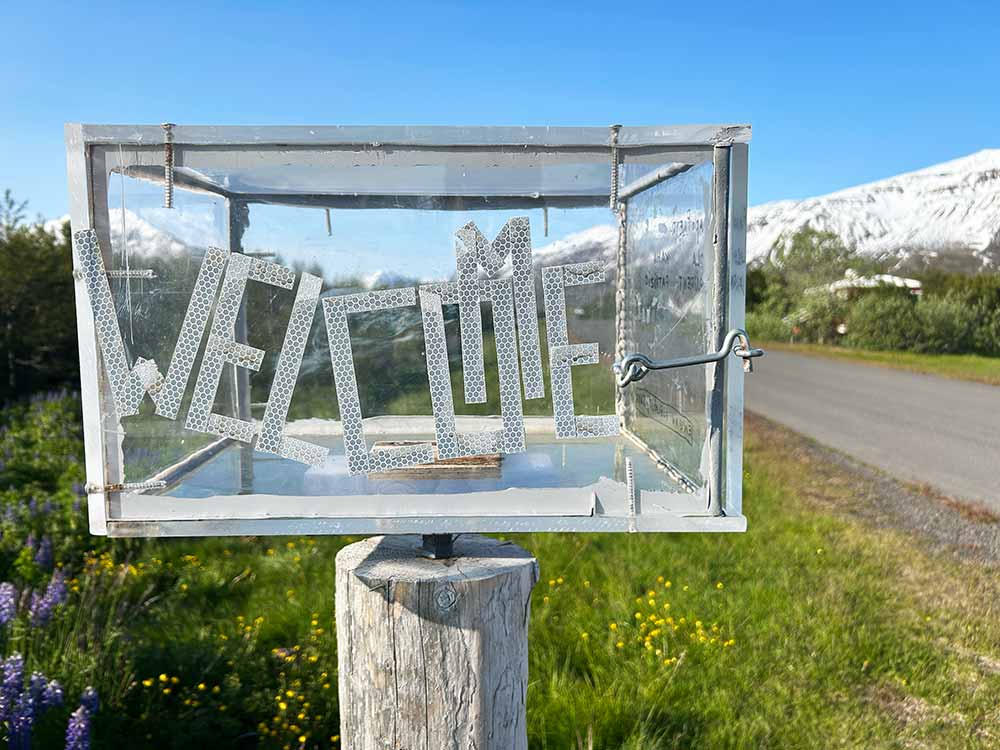
Photography courtesy of Grace Lee-Weitz | Hop Culture
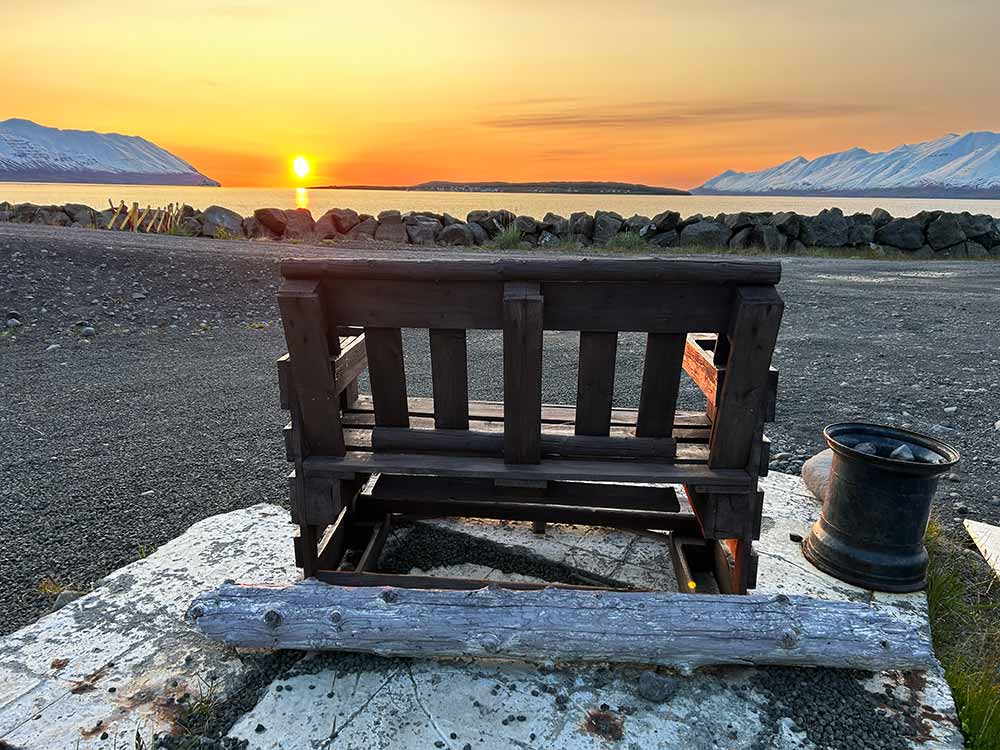
Photography courtesy of Grace Lee-Weitz | Hop Culture
The first thing you’ll need to know about traveling to Iceland is how to get to Reykjavik.
Iceland’s capital has two airports, but if you’re flying internationally, you’re coming into and out of Keflavik, which is about a forty-five-minute ride from the city center.
Getting into town, though, is super easy. We recommend booking either Flybus or Airport Direct, which can be done online beforehand or upon arrival (we’re type-A planners, so we did it ahead of time).
We personally took the Flybus, and it was a breeze. You can easily find the counter near baggage claim, and they’ll help direct you to your bus. Once on, you just sit back and relax. We actually landed in Reykjavik after midnight and could still easily navigate. What’s more, Flybus offers shuttle service to most lodgings in Reykjavik. You let them know your final hotel destination while buying a ticket, so that when you get to the main bus terminal in Reykjavik, they’ll direct you to a smaller shuttle that will take you right to the front door of your hotel. Pretty neat.
To hit all these remote breweries, you’ll need to rent a car. No way around that because you’re literally driving the entire length of the Ring Road. For Millennial American readers, you’ll want to ensure that you reserve an automatic car rental. Manual driving is relatively common in Iceland, and trust us, you don’t want to be learning how to drive stick and change gears for the first time here.
Having said that, except for one stretch of road on the Northeast coast that was completely gravel (in fact, for eighty miles, our GPS kept telling us to turn around because it didn’t even register this part as a road…but it was), the entire Ring Road is pretty well maintained.
We rented a little five-seat Suzuki that we’d definitely stop way short of calling an SUV. More like a tin can on wheels, this trusty rusty that made funny sounds every time we went over a speed hump performed admirably well. Take that for what you will—we’d recommend renting an SUV, but if you go a class lower, the roads were still maintained enough to accommodate.
Speaking of accommodations, we mostly stayed in apartments or lodging houses, which are similar to hostels, but with private rooms. We did, however, share bathrooms, kitchens, lounging spaces, and other amenities. Don’t expect five-star resorts here, but these places were completely clean, comfortable, affordable, and some even served free breakfasts.
To make things easy, we’ll provide the information on where we stayed each night below.
Lastly, you have to consider the weather when visiting Iceland. The climates vary drastically, so we recommend packing layers and bringing an anorak or raincoat. For example, we experienced seventy-degree days in Reykjavik and rain, snow, and sub-fifty-degree nights closer to the coast.
Also, consider what time of year you want to visit. We recommend the summer months (June to August) because you’ll experience nearly twenty-four hours of daylight, which was a very comforting thought while driving; we didn’t need to worry about dark conditions as we often pulled into our final destination around five or six o’clock each night.
In the winter months (November to March), you’re dealing with only four to five hours of daylight every day. Which is great for your chances of seeing the Northern Lights, but not for long drives. We planned this trip in the first couple of weeks of June and felt the weather and long days of sunlight suited us very well.
Additionally, a lot of the breweries mentioned below either shut down or operate on limited hours during the winter due to a lack of tourism, so visiting during the summer means you’ll have a better chance of actually grabbing a beer at these places.
A Brief Word on Beer Trends in Iceland
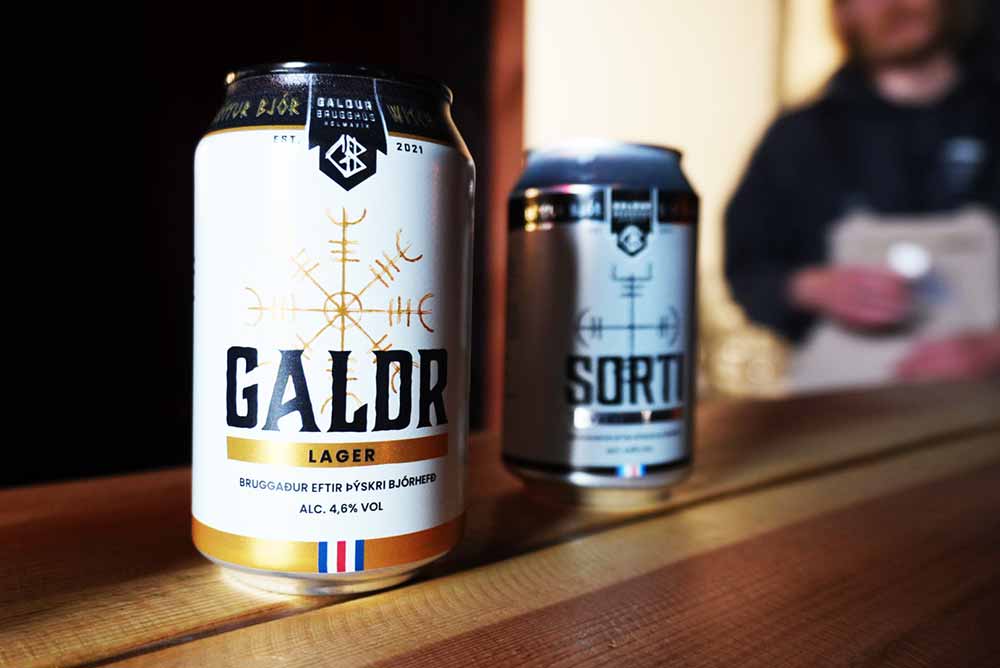
Photography courtesy of Grace Lee-Weitz | Hop Culture
Before we tell you about all the places we visited, it’s essential to understand Iceland’s beer culture.
Guess what? America wasn’t the only country to institute a period of Prohibition.
A ban on beer lasted in Iceland for nearly seventy-five years from 1915 to 1989, and it has shaped much of the growth of craft beer in the country. An archaic approach, not only legally but also socially, has stunted a burgeoning industry.
“Getting pissed on Friday and Saturday is fine, but a glass of wine with lunch on Monday meant you were an alcoholic,” says Toggi, who started Jón Riki Brewery in Hólmur and recently opened up Horn Brewery in nearby Höfn.
Húsavík Öl’s owner told us that people in the town still drive by and gawk at those drinking inside his taproom. There is an ingrained stigma around alcohol in Iceland that has been hard to crack.
And things don’t get any easier when it comes to the law. Legally, the only places where Icelanders can buy beer are state-run liquor stores called the Vínbúðin. From those we talked to, opinions varied, but most spoke of the challenges of getting their foot in the door of a very rigid system.
“It’s a weird system. It’s good and bad,” says Beljandi Brugghús head brewer Atli Þór Ægisson. “If we apply to sell our beer, they do have to take it in, but they start limited—maybe put it in four stores in Reykjavik—and then you have to sell a certain amount to get a wider distribution.
The stores favor Iceland’s bigger breweries like Viking Brugghús, which the Coca-Cola Company owns.
“The two big factory breweries have a monopoly on the markets,” explains Atli. “Probably well over ninety percent of beer sold there is theirs.”
Plus, they also pay to play at bars.
“If you’re starting a bar or starting a restaurant, they will come to you and say, okay, we will provide all the glasses, we will provide all the signs, we will give you this much discount,” says Professor Bjarni Kristjánsson, who runs the non-profit group Bjórsetur Íslands (aka the Icelandic Beer Center). “But the only thing is that you have to buy all your drinks from us.”
I’m simplifying a very complicated history here, but to keep this brief, for these reasons, Iceland’s first craft brewery—Bruggsmiðjan Kaldi—didn’t appear until the early 2000s.
Which also means, beerwise, you’ll find a lot of the same styles everywhere you go. Many of the breweries we visited featured three or four core beers, often a session IPA, amber, sour (many times made with skyr, an Icelandic yogurt), and a light lager, along with seasonals positioned around holidays like Christmas, Easter, and summer.
Much like how American craft breweries repurposed old industrial warehouses, Icelandic craft breweries often pop up in what’s around them—disused slaughterhouses and fishing factories.
Despite all of these hurdles, the more breweries I visited, the more one word kept popping up in my head: proud.
These entrepreneurs are incredibly passionate about what they do, often incorporating local lore, stories, and even mythical characters into their logos, beer names, and styles. Every brewery, even those in remote towns, miles from anything, had a story to tell.
So, we encourage you to listen to them.
Day One: South Iceland and the Westman Islands
Ölverk
Breiðamörk 2, 810 Hveragerði, Iceland
One of our first stops of the trip, Ölverk, is only a short half-hour drive outside of the center of Reykjavik, making it a great place to start your Iceland drinking adventures.
Opened in May of 2017, Ölverk is a pizzeria and brewery powered by geothermal energy.
At Ölverk, started by Laufey Sif Lárusdóttir and Elvar Þrastarson, who showed us around the brewery during our visit, “We just try to make clean beer styles,” Þrastarson tells us.
For instance, we encourage you to try the Eilífur, a German pilsner that Elvar calls his go-to.
Basically, all of Ölverk’s beers pair perfectly with its wood-fired pies. You can’t go wrong with the brewery’s version of a margherita, but you’ll also find unique works here, such as one with bacon, dates, and blue cheese or another with white sauce, brie, blue cheese, walnuts, pear, spring onion, honey, and chili flakes.
Is there a better way to start your Ring Road exploits than with hearty pies and pints? We challenge you to find something superior.
Activity: Hike Eldfell
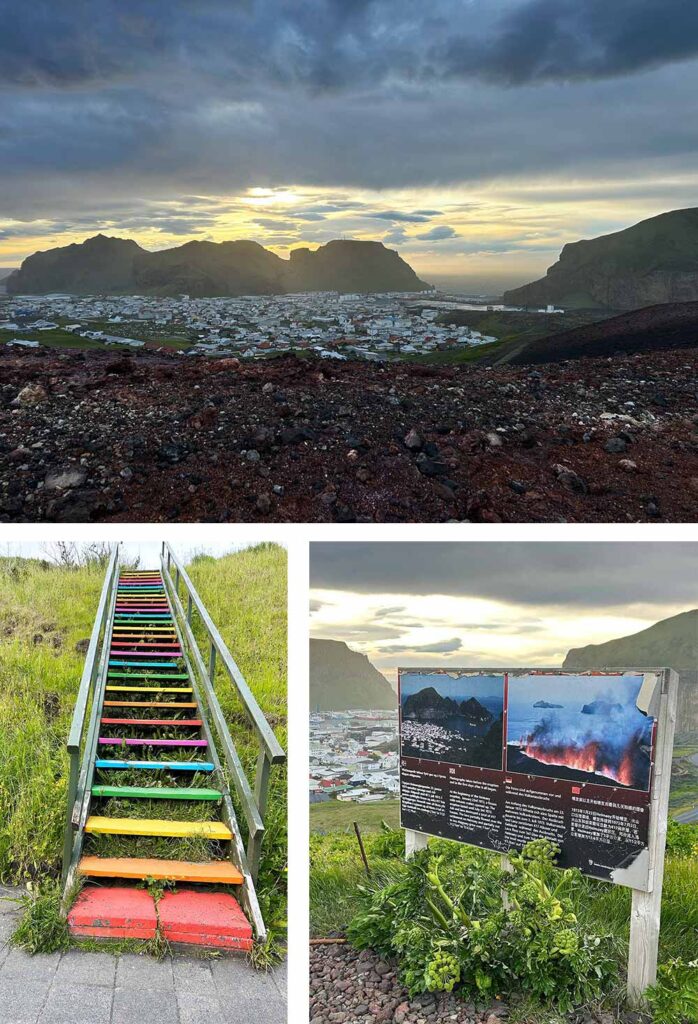
Photography courtesy of Grace Lee-Weitz | Hop Culture
After lunch at Ölverk, we drove to a ferry that took us to Heimaey, the only inhabited island of the Westman Islands. Here, I did something super fun and also wildly stupid. While I highly encourage you to try this activity on your own, please learn from my mistakes.
I’m clinging to the side of a volcano. Black ash slips and crumbles beneath my feet as I stumble ever higher. This has got to be one of the stupidest things I’ve ever done. That refrain plays in my head over and over. And yet my feet fly forward, propelled by a gust behind me. Turning around, I’m smacked with dusty, turbid air, like opening the portal on a boil kettle. My eyes immediately started to tear.
This has got to be the stupidest thing I’ve ever done.
Almost to the top. I grab onto a wooden plank sticking out of the ground; it marks the barely seen trail, and I hunker down.
Out over the rim, I see the entire town spread out like sheep in a field.
Another gust of wind threatens to topple me over. It’s 10 p.m., the sun still shining brightly. I’ve told no one where I’m going. With one final glance at the steep pitch, which can’t be more than a five-minute walk, I make my choice and head back down the mountain.
Eldfell, the volcano on Heimaey, which last erupted just over fifty years ago in 1973, has beaten me…for now.
I didn’t actually mean to hike up this entire volcano. But while going for a walk, I stumbled across a set of rainbow stairs. How could I not follow them?
The hike wound through underbrush and ash, zigzagging up the volcano. I went completely unprepared, which I don’t recommend. Instead, plan to wear sturdy shoes, as the path can become gravelly. I found myself slipping multiple times, and with drop-offs on either side, you certainly don’t want to put a foot out of place. And if it’s one of the windiest weekends of the year, I wouldn’t recommend trying this trail.
From the top, though, the views of the town at “sunset” are breathtaking.
Plus, once you get back down, you can visit the island’s only brewery, which serves up a namesake Irish red ale paying homage to the very volcano you just climbed.
The Brothers Brewery
Bárustiger 7, 900 Vestmannaeyjar, Iceland
I felt much safer drinking The Brothers Brewery red ale, called Eldfell, than stupidly trying to hike up the mountain during some of their windiest days of the year.
We’re sitting safely in the brewery’s taproom chatting with one of the co-founders, Jóhann Ólafur Guðmundsson.
“It started with me and a friend of mine getting drunk in a summer house in 2012,” Jóhann tells us.
The two looked at the ingredients in the beer: water, barley, hops, and yeast.
“It’s four ingredients,” he says, “how can we f**k this up?”
The former computer programmer and his friend had never even homebrewed when they started putting together the idea for the brewery.
In April of 2013, they got together to watch the Masters Tournament and brew beer. “We had some fun in the basement,” he recalls.
Brewing a pale ale and a wheat beer, Jóhann felt the beer came out fantastic. But after giving it away to friends and family, “they thought it was disgusting!”
But the beers kept getting better.
Their imperial stouts started winning some awards. And the brothers in ales started gaining recognition, especially locally.
For Jóhann, Brothers Brewery is a local brewery. And that’s just the way he likes it.
Born on Heimaey, Jóhann moved to Reykjavik for school but returned seven years later. He hasn’t left since. It’s where he’s raising his family and now his business. He’s very proud of his family’s roots on the Westman Islands, where his grandparents survived that volcanic eruption.
He has history there, so many of the beers’ names reflect that heritage.
Like Gölli, an IPA named after the local drunk who died in 1970. Jóhann says Gölli is somewhat of a legend, with songs and poems written about him.
Or Eldfell, the red ale named after the island’s volcano. Since Jóhann gets most of his ingredients from the mainland (including water), when he has an opportunity to feature something local, he takes it. In Eldfell, he adds a local seaweed (dulse). “We go out and pick it and, over summertime, we dry it and freeze it,” he says. “It gives this umami flavor.” He balances that with some chilis, which also represent the heat and redness from the volcano.
It’s very subtle, but you get a lot of different flavors when you drink this beer.
Locals like to stick to the brewery’s session IPAs—Sigla Humlafley and Sumarbjor.
But whatever you drink, don’t leave Brothers Brewery without trying some of Jóhann’s imperial stouts.
We fell in love with D’or Bragi, which Webb found “so clever” because of how easy it was to drink.
“It’s super smooth,” agrees Jóhann.
At 10.5% ABV, this is a big beer, but it’s elegantly understated—the person at the party you don’t notice right away, but once you do, you can’t take your eyes off of them.
Jóhann attributes this to his brewing techniques. Without adding any adjuncts to his stouts, Jóhann instead takes each one through a double mash. “I mash the first half of the beer and then dump all the grains in and do another mash,” he explains. “So no added sugars or added anything.”
He’s simply extracting the flavors and textures from the grains themselves.
“I never planned them,” says Jóhann, “but people have been saying these are the best imperial stouts.”
We can safely agree.
Dining: Gott Restaurant
Bárustígur 11, 900 Vestmannaeyjabær, Iceland
For dinner, Jóhann from Brothers Brewery recommended we try the Gott Restaurant, just a couple of doors down from the brewery. Run by Sigurður Gíslason and his wife Berglind Sigmarsdóttir, Gott serves fresh, creative dishes with a focus on local produce and products.
They purchase fresh fish from the market daily and prepare all their stews, soups, sauces, and cakes on-site.
We recommend the Seafood Pan, which will feature either fresh seafood or fish alongside grilled vegetables and potatoes.
Stay: Árný’s Guesthouse
Illugagata 7, 900 Vestmannaeyar, Iceland</3m>
This lovely little cottage offers five different rooms, two shared bathrooms, and common spaces that include a communal kitchen with coffee and tea, a living room, and a sun house for relaxing after a day climbing up volcanoes, searching for puffins (which can be found at certain times of the year at different points on the Westman Islands), and drinking beer.
Day Two: Vík, Hólmur, and Höfn
Smiðjan Brugghús
Sunnubraut 15, 870 Vík, Iceland
From the Icelandic word for blacksmith, Smiðjan Brugghús forges bold beers and even bolder barbecue.
Yes, in Vik, Iceland, you’ll find a brewpub that serves up juicy burgers and ‘que, including a rack of St. Louis-style ribs right from their smoker, brushed with a stout barbecue sauce.
You can also sample from a tasting tray that includes half a serving of smoked spare ribs, smoked pork shoulder, and buffalo chicken wings, accompanied by beer-battered onion rings, apple salad, and homemade potato salad.
Beerwise, co-founders Sveinn Sigurðsson, Þórey Richardt Úlfarsdóttir, Vigfús Þór Hróbjartsson, and Vigfús Pál Auðbertsson have a pretty standard range, including a New Zealand DIPA, raspberry sour, imperial stout, session IPA, NEIPA, hoppy lager, pils, and more.
We all opted for Slip, the Icelandic brewery’s take on a 4.7% ABV German-style pilsner hopped with Hallertauer Blanc. The brewery calls this one “perfect for the crispy boys.” We call it perfect for the barbecue boys.
Activity: See the Icebergs at Jökulsárlón Glacier Lagoon
781, Iceland
About a two-and-a-half-hour drive from Smiðjan Brugghús, you’ll come across Jökulsárlón Glacier Lagoon. Bordering Vatnajökull National Park, this startling blue lake is home to large pieces of ice that break off from the Breiðamerkurjökull Glacier, making their way down a small channel to the Atlantic Ocean.
Since this is Iceland’s most famous glacier lagoon, it’ll be pretty packed in the summer months. We recommend making a reservation for one of the lagoon’s experiences ahead of time.
You can do a more extended Zodiac tour, which takes you closer to the glacier, or an amphibious boat tour that sails between the icebergs themselves. We booked an excursion for the latter, but due to windy conditions, our boat tour was canceled. All that is to say, your plans can change on a whim, but even if you can’t go out on the boats, just walking around the lake and observing the massive ‘bergs is worth the pit stop.
Pro Tip: Follow the path under the bridge to Diamond Beach, a black sand beach known for huge, glistening ice parts that break off the icebergs and wash up on shore. These are like beautiful ice castles.
Horn Brugghús and Heppa Restaurant
Heppuvegur 6, 780 Höfn í Hornafirði, Iceland
A surprise stop on our trip, Horn Brugghús references the Vestra-Horn Mountain (nicknamed the “Batman Mountain” because from a certain angle it looks like the superhero’s logo). This local landmark, co-founder Toggi feels, is an integral part of the town’s identity.
“One of our goals for the brewery is to become a part of what people first think of when they mention the town of Höfn,” says Toggi. “Connecting our name to something truly local and never changing sort of anchors us and helps in finding our way forward.”
Toggi has roots in the area, where he actually started a now-closed brewery called Jón Riki at his parents-in-law’s guesthouse in Hólmur (and coincidentally where we stayed this night—more on that below).
Toggi developed an appreciation for beer while attending the University of Ghent. Drinking cheap beers eventually morphed into guezes from Cantillon and Belgian strong ales from the local student hangout, Delirium Café.
When he started Jón Riki, Toggi thought, “How hard can it be?” When they bought a 350-litre brew kit, “We had no idea what we were doing,” he laughs. “It was always just a hobby and, of course, learning how to brew.”
Eventually, Toggi’s hobby outgrew the tiny corner of the dining room at his in-laws’ bed and breakfast. He upgraded to Horn, which he now owns with three other local families. He hopes the brewery will be a pit stop for folks, like us, traveling from the glacial lagoon and onward around the Ring Road.
“We have no interest in selling beer anywhere except our local area,” he explains as he shows us around.
As the only craft brewery in the area, Horn already has a pretty solid customer base. People are drawn in by consistently good beer made by locals.
“We’re not going to hit a home run with each one,” says Toggi. “We want to learn, learn, learn to be consistently good … with not just beer nerds but everybody.”
For instance, The Local , a classic light lager with notes of grain, coriander, corn, and a faint bitterness. “We wanted that beer to be a go-to beer for every occasion in Höfn,” says Toggi.
Or The Lobster, one of the most unique beers Horn makes. The 6.5% ABV stout includes a lobster stock as a nod to the building’s roots as an old fishing facility and slaughterhouse. “It doesn’t add much, but it gives a little taste from the ocean,” says Toggi. “If you want, you can definitely taste the lobster.
Seven core beers—premium lager, West Coast IPA, session IPA, gose, Vienna lager, stout, and light lager.
Toggi is most proud of Horn’s Codzilla, which he calls “our best beer.” The West Coast IPA features Idaho 7, Mosaic, Harlequin, and Centennial hops along with CTZ for bittering.
Pro Tip: Since Horn is connected to Heppa Restaurant, it’s also a great place for dinner.
Toggi has a twenty-five-year background in the restaurant industry, starting with a job washing dishes at sixteen. But at this point, Toggi’s love for beer has overtaken food.
As he says, “I will be in the brewery forever for sure.”
Which makes sense because for us, Horn was a place we never wanted to leave.
Stay: Hólmur guesthouse, Hólmur Farm
781, Hornafjörður, Iceland
One of my favorite stays of the entire trip, Hólmur guesthouse is run by a lovely couple, Gunna and Maggi, along with their daughter Arndís, who is married to Toggi from Jón Riki and Horn Brugghús.
Hólmur means “island” in English, a nod to the area where we’re staying, which was originally surrounded by small streams. The water has dried up, but the hospitality flows aplenty.
In the morning, head over to the red building for a continental European breakfast. Doesn’t get much better than sitting down with a view of a stunning glacier in front of you, while eating bread smeared with housemade rhubarb jam.
Next to us are rows of plants waiting to be planted. The proprietor, Gunna, tells me she had a feeling in her bones that the lovely May weather would turn in June, so she held off planting them. As we look out at the wind and spittle, it’s hard to disabuse her of that sixth sense.
I speak with Gunna long enough that she pulls out some old photos of the property, which her husband’s parents bought in 1935.
This family has roots here, and you can see, smell, taste, and hear it everywhere you look.
Day Three: East Iceland: Breiðalsvík, Stöðvarfjörður, and Egilsstaðir
Beljandi Brugghús
Sólvellir 23A, 760 Breiðalsvík, Iceland
A two-and-a-half-hour drive from Hólmur, you’ll find Beljandi Brugghús.
Housed in an old slaughterhouse (a theme we found throughout the trip), this little rural brewery in a village of around 140 has revived Breiðalsvík.
“We wanted to try to find out if we were the smallest village with a brewery in the world,” shares head brewer Atli Þór Ægisson as he shows us around.
A couple of locals, the owners, renovated the building to make it an attraction for the sleepy little village. “It’s crazy to think about,” says Atli, “but they had the idea to open a brewery in the middle of nowhere.”
With the jobs and tourism Beljandi has provided to the town, Atli believes the brewery has truly become an essential part of the area’s fabric.
“I think this town would have slowly died if [the brewery] hadn’t come here,” he says.
Today, Beljandi sits right on one of Iceland’s East Fjords, attracting people with the promise of fresh, local craft beer and, if you’re lucky and the weather isn’t too foggy, incredible views. The water means something at Beljandi.
The name itself, Beljandi, translates to “big stream” or “heavy rain” and is also eponymous for a local waterfall. The brewery’s logo, a fisherman at the helm, is a nod to the village’s fishing history.
When Atli takes us upstairs to the pub, it’s like we’re transported to an old-school hunting lodge.
On one wall, a reindeer head (which Atli tells us the owner hunted himself) overlooks a pool table and darts board. Above our heads are lights made out of old herring barrels, a nod to what used to be Iceland’s most significant industry. But the centerpiece is the bar, made up of thirty kilos of old Icelandic coins. “The bar top is one of the first things people notice,” explains Atli, who joined the brewery in the summer of 2018.
After admiring the handiwork, we look up at the taps, the reason we really came here, right? Atli gives us a taste of some of his favorite beers—a brown ale called Sauður, a blackberry sour called Brómeó that’s kettle soured with skyr, Iceland’s own version of yogurt, and a pale lager called Heiða.
Beljandi’s best-seller, the aforementioned German-style hoppy lager, includes a grist of pilsner and light Munich malt with a touch of dextrine malt and melanoidin, along with Saaz and a dry hop with Mosaic.
A play on words, heiða is the first part of the Icelandic word for honest, heiðarlegur. “The plan was to make an honest lager,” says Atli, noting it has become so popular that I need to make sure that beer never runs out.”
As is Sauður, which basically means sheep in Iceland, but farmers use that word for a castrated ram, too. It’s also commonly used to call someone stupid or silly, in a friendly way. Well, call us silly because we stupidly loved this brown ale, which Webb called one of the nicest he’s had in a while.
While a grist of eighty-five percent pilsner malt with some crystal and melanoidin and a little bit of chocolate malt and Special B / Caraaroma make up the base of this beer, Atli believes it’s the Weihenstephan yeast, W-34/70, that truly gives this brown ale its character.
Another pun, Brómeó plays off the Icelandic word for blackberries, brómber. Although in my head, I romanticize this could be a portmanteau of brómber and Romeo, so it’s basically a romantic expression of a blackberry sour. But Atli says that isn’t true.
Apparently, a visiting Canadian brewer loved this beer so much that he later emailed Atli for the recipe.
Although located in a remote fishing village, Beljandi seems to have a worldwide reach. Behind the bar, Atli points out different bottles, including one of Dom Perignon, which he says every French person who visits gets angry at him for because he doesn’t store it on its side. A bottle of Buckfast was brought back from Scotland by a Polish staff member who lived in Glasgow for ten years.
“He left the bottle because he knew that every Scottish person who came in here would notice it,” laughs Atli.
Beljandi hasn’t just revitalized this little village, it’s put it on the map. If you have to condense your time in Iceland, make sure to include Beljandi as a must-visit.
Activity: Petra’s Stone Collection: The Largest Rock Collection in the World
Fjarðarbraut 21, 755 Stöðvarfjörður, Iceland
The States might be known for quirky roadside attractions like the Biggest Ball of Twine, the SPAM Museum, and the International Banana Museum. In the remote town of Stöðvarfjörður, Iceland, you can find what is purportedly the world’s largest private selection of stones—Petra’s Stone Collection
As someone who collected rocks as a kid, I loved this wacky pit stop.
The collection of Ljósbjörg Petra María (born 1922), the rocks that line the walls and garden of what used to be Petra’s home number in the thousands. Petra, whose name somewhat ironically means “stone” in Greek, started collecting minerals in the late 1940s. Although rocks had fascinated her from an early age.
Over the years, Petra found and kept stones from the nearby mountains. At the time, roads didn’t yet connect all parts of Iceland, making it hard to travel around. While most expected her to be a housewife and bake bread, this stone hunter instead took to the surrounding wilderness and forests for the thrill of seeking out the next big find.
Today, hundreds of visitors come from all over the world to see Petra’s pebbles (trust me, they’re way more than just pebbles), making this one of Iceland’s most popular tourist attractions.
“You have to go to Petra,” Atli encouraged us. “[Collecting rocks] is a thing in this part of the country; it’s an impressive museum.”
Honestly, I felt this stop was totally worth it. Petra has a fascinating story that transcends gender boundaries, and it’s incredible to see some of the gems she collected.
Others might find this just a kitschy corner of the world, but to me, I could read a story of Iceland’s history through its incredible, intricate, and intoxicating rocks. If that sentence doesn’t excite you, then maybe you can skip this. But if you can suspend belief for just twenty minutes and see something out of the ordinary, give Petra’s Stone Collection a try.
Pro Tip: Snag lunch here. The cafe serves a very serviceable bowl of soup and bread.
Askur Taproom
Fagradalsbraut 25, 700 Egilsstaðir, Iceland
Opened in 2018, Askur Taproom is essentially a brewery collective, offering its brewhouse to various brewers in the area.
Which is why, when you visit, you’ll see a taplist that features brands like Müli and Astri.
As the bartender explained to us, any local brewer in the area can use the system to brew.
We have to say that this is the place to be in Egilsstaðir. When we walked in on a Friday night, the place was packed—each crowded table crammed with families, friends, flights, and piping hot pies.
In fact, we had to wait forty minutes just to order food because the kitchen shut down due to the high volume of orders.
But it was worth it.
Great stop for dinner and a post-driving flight of beers.
Stay: Lyngás Guesthouse
Lyngási 5-7, 700 Egilsstaðir, Iceland
One of the more popular guesthouses in Egilsstaðir, Lyngás Guesthouse doesn’t look like much on the outside, but inside you’ll find private rooms with hotel-quality beds, shared single bathrooms and showers, and a huge communal kitchen. Location is really the priority here, as Lyngás Guesthouse is just a five-minute walk from Askur Taproom and pretty much every other dining option in Egilsstaðir.
Day Four: Northeast to North Iceland: Borgafjörður Eystri and Mývatn
KHB Brugghús
720 Borgafjörður Eystri, Iceland
Forty-three and a half miles from the nearest city, over a mountain pass, and out on the northeastern coast of Iceland, a peeling white-and-pink building belies a modern brewery within.
Here, in the middle of nowhere, at the edge of the world, we found a brewery making one of, if not the best Czech pilsners in all of Iceland.
KHB Brugghús opened in the coastal village of one hundred people called Borgarfjörður eystri.
In summer, people flock in the thousands (67k on average) to visit Puffin Island, a crag in the middle of the ocean that puffin colonies call home for the nesting season.
KHB Brugghús Co-Founder Helgi Sigurdsson, along with his partner Auður Vala Gunnarsdóttir, purchased the old grocery store in 2016.
Standing for Kaupfélag Héraðsbúa, a local cooperative that originally operated where the brewery now stands, KHB’s building dates back to 1897, making it one of the oldest in the village. But the grocery store and community co-op eventually went bankrupt.
When Helgi and Auður started KHB, they petitioned the town’s three-person council to use the original name and logo, hoping to preserve the co-op’s legacy.
“The building was so deeply rooted in local memory,” says Helgi. “We’ve been proud to carry the heritage forward.”
One beer in particular in this nautical-themed taproom stood out to us—the Borghildur Czech pilsner.
Curious how a top-notch Czech pilsner made its way to a remote village in Iceland?
So were we.
“We got in contact with a brewer in Czechia,” Helgi told us. “A former head brewer for Pilsner Urquell.”
Josef Krýsl landed in Borgarfjörður eystri per special entry and under strict regulations during the summer of 2021—what Helgi calls the “COVID summer.”
Stuck in the little Icelandic town, the former brewmaster who now travels the world building kits for breweries, couldn’t leave for a few months.
“So he taught us how to brew,” laughs Helgi.
Can you imagine a better scenario for a new brewery than a former Pilsner Urquell brewmaster unable to leave your town for several months with nothing better to do than write recipes and show you the ropes?
KHB Head Brewer Þorsteinn Brandsson (aka Steini), who lives in a yellow house we passed on the way in, worked side by side with Krýsl, gaining invaluable knowledge and experience.
For Borghildur, which won a silver medal at the London Beer Competition in March 2024, Steini starts with a Pilsen malt from Sladovna Bruntál. He does a single decoction, “but with a recipe and guidance from my Czech brewmaster,” he wrote to Hop Culture after our visit. For hops, Steini notes that he adds Premiant for bittering and Saaz for aroma and flavor.
To this day, Steini still calls Krýsl with questions.
“It was truly fantastic to have Josef as our mentor,” says Helgi. “We were incredibly fortunate to have him join us.”
And we were fortunate to taste this beer.
Later in the car, as we bump along to see those famous puffins, we discuss—still mystified that we could find such a gem in such a remote place.
“I thought that was going to be somebody doing a little bit of homebrewing out on the edge of the world,” dithers Webb. “But to come up with a seriously competent pilsner in the middle of nowhere…”
He trails off before adding, “They were genuinely good.”
We all shake our heads vigorously in agreement.
“But I guess if you had a former brewmaster of Pilsner Urquell stranded for four months,” he continues, “you’re going to learn something, aren’t you?”
After just a few hours at KHB, we sure did.
Activity: Hafnarhólmi: Puffin Island
G6RV+XF3, 721 Bakkagerði, Iceland
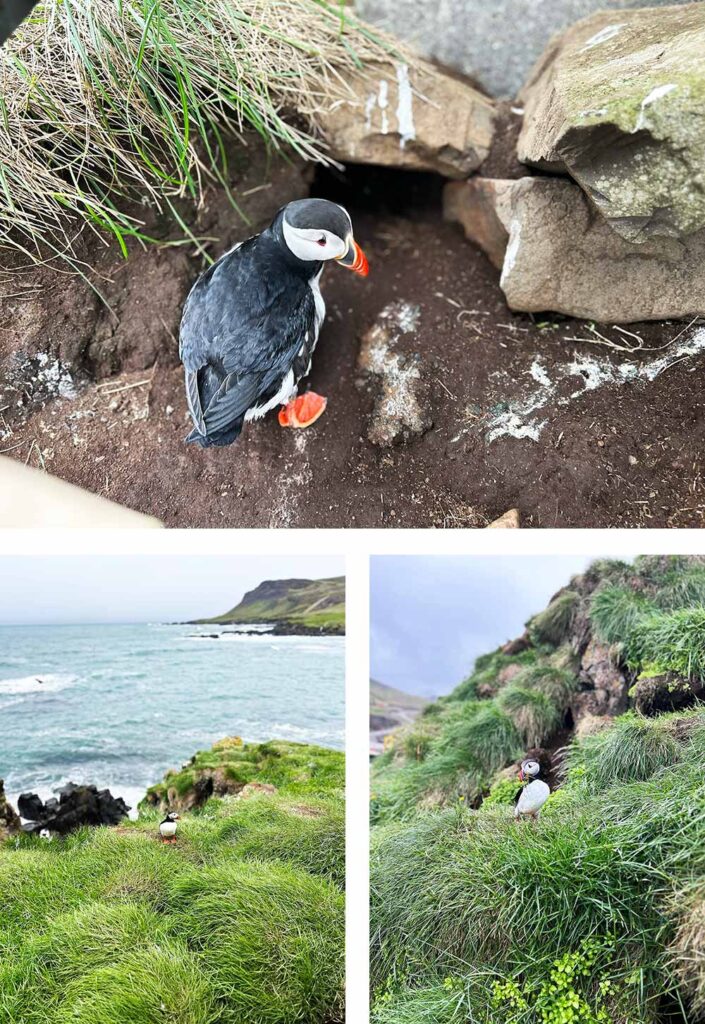
Photography courtesy of Grace Lee-Weitz | Hop Culture
Helgi said we couldn’t leave Borgarfjörður eystri without visiting Hafnarhólmi, a literal puffin paradise.
Every year, ten thousand pairs of puffins nest in Borgarfjörður, many of which can be found on this little island jutting out into the harbor. Nesting from mid-April to mid-August, the puffins were out in full force for us when we visited in June.
This little grass-covered knoll is quite possibly the best place in Iceland to get up close and personal with puffins. With landings and wooden stairs built right into the cliff, you can get mere feet away from the mating birds.
Only a ten-minute drive from KHB, Hafnarhólmi is a must-do activity, in our opinion.
Mývatn Öl
Skútustaðir 2, 660 Mývatn, Iceland
Started at the beginning of 2022 as a small nanobrewery serving the Sel-Hotel, Mývatn Öl is now housed in the souvenir shop across the street, Kaffi Sel.
Walking inside, you might be convinced that this place just sells local trinkets. But after perusing the aisles of puffin magnets, geyser mugs, and Northern Lights water bottles, head to the register. To the right, you’ll notice a few taps.
We recommend the Vindbelgur Geysir Bread IPA and Skútinn IPA.
The former includes geothermal-baked geyser bread, a nod to the geothermal activity around Lake Mývatn in this northern part of Iceland. Bready, malty, and full-bodied, this hoppy ale tasted a bit like the hearty rye bread I’d been eating at breakfast every morning.
The latter is an Untappd Community Awards silver winner with classic notes of grapefruit.
Pro Tip: You can eat lunch here as well.
Activity: Goðafoss Waterfall: Iceland’s Largest
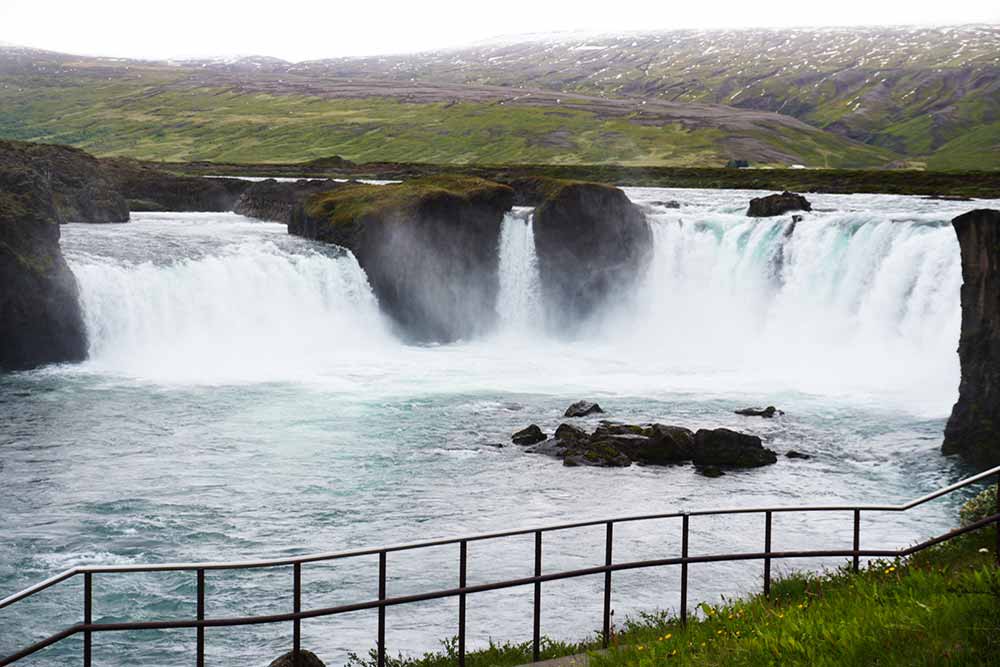
Photography courtesy of Grace Lee-Weitz | Hop Culture
One of the defining landmarks of Iceland, waterfalls exist everywhere. Driving down Route 1 (aka the Ring Road), you’ll see many trickling paths of water cascading off cliffs. But by far, Iceland’s most popular waterfall, Goðafoss, is a must-stop between Mývatn Öl and your destination for the night, Húsavík.
The thirty-nine-foot-high (twelve meters) waterfall plunges into the Skjálfandafljót river. The geographical landmark appears almost out of nowhere, a tiny dip in the earth that grows as you get closer.
Is this the largest waterfall I’ve ever seen in my life? No, not even close (hello, Niagara Falls), but it is worth a stop to stretch the legs.
Dining: Naustið
Ásgarðsvegur 1, 640 Húsavík, Iceland
A recommendation from one of Webb’s friends, the family-run Naustið specializes in excellent, fresh-caught fish. And no wonder. Naustið is located in Húsavík, the whale watching capital of the world.
You can’t miss the eatery’s splashy yellow exterior, but it’s the grandmotherly vibes and down-home cooking inside that you’ll remember for a long time.
For a short time, while you’re inside Naustið, you become a part of their family. The fish and seafood are fresh and local, vegetables are grown nearby, the meat comes from the area’s farms, and the bread and pastries are all made in-house every day.
Go for the signature fish soup (they even make a vegetarian version!) or tuck into traditional Icelandic mashed fish served with boiled potatoes and rye bread. The grilled salmon in lemon butter sauce is also a house favorite.
Stay: Húsavík Cape Hotel
Höfði, 640 Húsavík, Iceland, Iceland
A family-run hotel, Húsavík Cape Hotel offers up some history with a side of fantastic views over the town, harbor, and ocean. Located a bit outside of the city center, this hotel is still just a ten-minute walk from all the activities we’ll talk about below. Plus, you get a complimentary breakfast. It’s not the best free breakfast we had on this trip by any means, but well, it was free.
Day Five: North Iceland: Húsavík
Editor’s Note: At this point, we’d spent four days driving long distances and visiting up to three breweries a day, so we opted to take a bit of a rest day in Húsavík. We’ll list out some of our favorite activities below, but rest assured that this fishing village wasn’t just a stopover; we also wanted to hit up the town’s only brewery.
Activity: Hike/Run to Lake Botnsvatn

Photography courtesy of Grace Lee-Weitz | Hop Culture
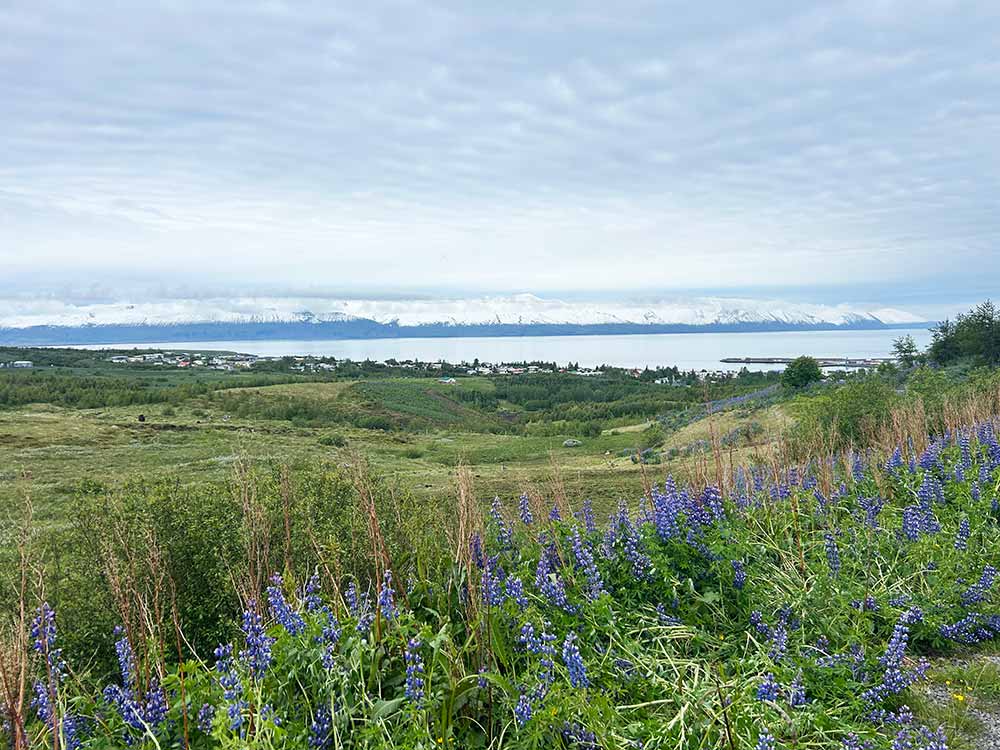
Photography courtesy of Grace Lee-Weitz | Hop Culture
Another landmark that I stumbled across! On a morning run, I veered off onto what looked like a cool footpath. The dirt trail wound through forests, up little embankments, over trickling streams, and ended at a lake called Botnsvatn.
Serene and peaceful at the foot of the rising Húsavík Mountain peak, this lake was a true treasure.
The best part, though? Running back into town, the trail offered breathtaking views of ice-covered peaks and Húsavík’s harbor.
Editor’s Note: While you can definitely picnic or fish by the lake, it’s not recommended to actually swim in it due to larvae that live in the water. Signs near the water’s edge will warn you.
Activity: Húsavík Eurovision Exhibition
Laugarbrekka, 640 Húsavík, Iceland
Have you heard of Eurovision? I hadn’t. Apparently, it’s an uber-popular European singing competition. Maybe you’ve seen Netflix’s Eurovision Song Contest: The Story of Fire Saga, filmed in Húsavík.
No? Well, let me try to explain this phenomenon.
If the Super Bowl halftime show became its own competition, that might be Eurovision. Or if American Idol met America’s Got Talent, with each act representing a different country. It’s like the Little League World Series of singing competitions. Dancing With the Stars? Do you get the picture?
Well, if not, then you should visit the Húsavík Eurovision Exhibition, located right next to the Cape Hotel.
One of a kind in the world, this exhibition shows the history of Europe’s legendary song contest, including a personal exploration of Iceland’s participation and Netflix’s production.
This is a fun place to kill a few hours or appreciate a contest that has captivated Europe since the late ‘50s.
Activity: Whale Watching
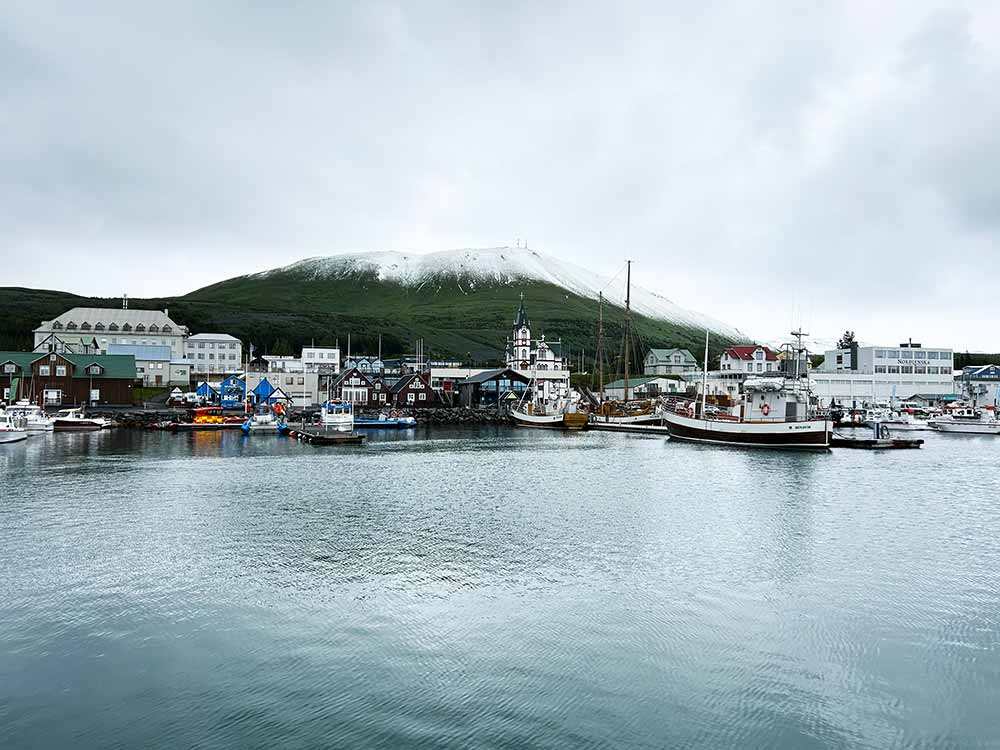
Photography courtesy of Grace Lee-Weitz | Hop Culture
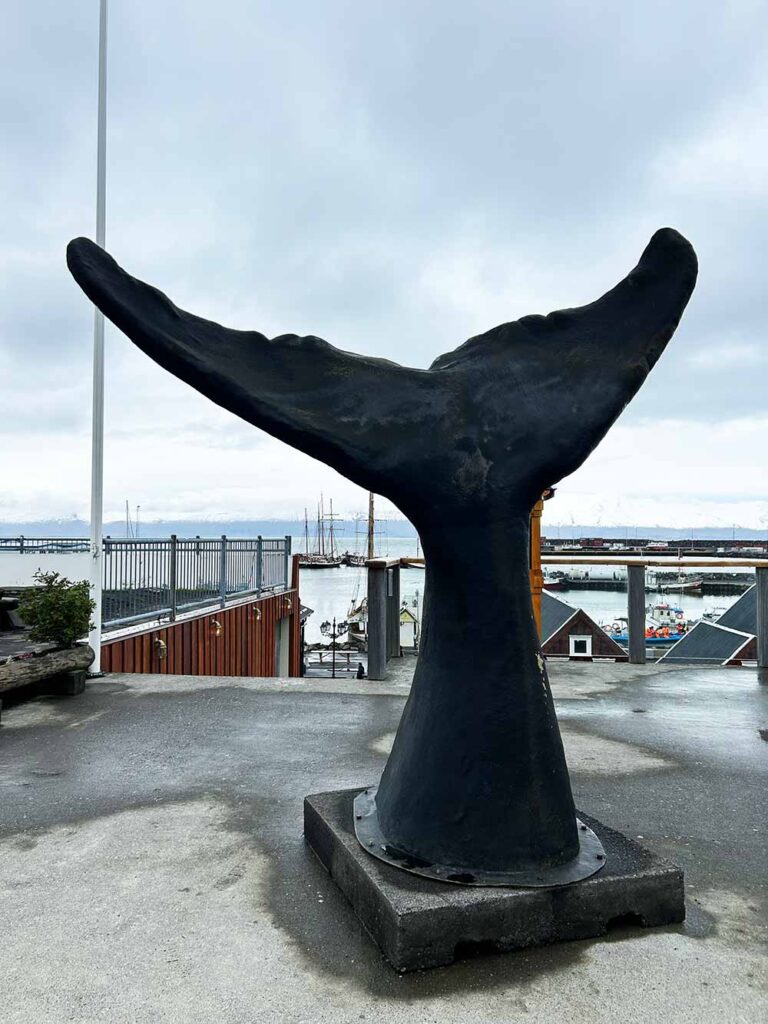
Photography courtesy of Grace Lee-Weitz | Hop Culture
Renowned as one of the best places to go whale watching, Húsavík’s Skjalfandi Bay has nutrient-rich waters that attract humpbacks, minkes, and even the elusive blue whales.
You’ll have two options to go whale watching. You can choose one of the older, rickety wooden fishing vessels or newer, sleeker jet boats. The former are slower and more prone to rocking (i.e., don’t choose this option if you easily get seasick). They fit more people and have more room to move around, so this could be a good option if you have a large group, but they also can’t get as close to the whales. The latter offers small-group adventures and provides a closer experience with the whales.
To be completely honest, we visited Húsavík at the tail end of a storm. When the lady at the front desk warned us that conditions were very rough in the bay, moving her hands up and down frantically, we opted not to go whale watching here (we would the next day in Akuyeri).
Having said that, the company graciously offered us a full refund, so we appreciated their honesty in allowing us to make an informed decision.
Hopefully, when you visit, you’ll have blue skies and calm waters! If you do, don’t skip out on the whale watching; it’s a genuinely unique Húsavík activity.
Activity: GeoSea Geothermal Sea Baths
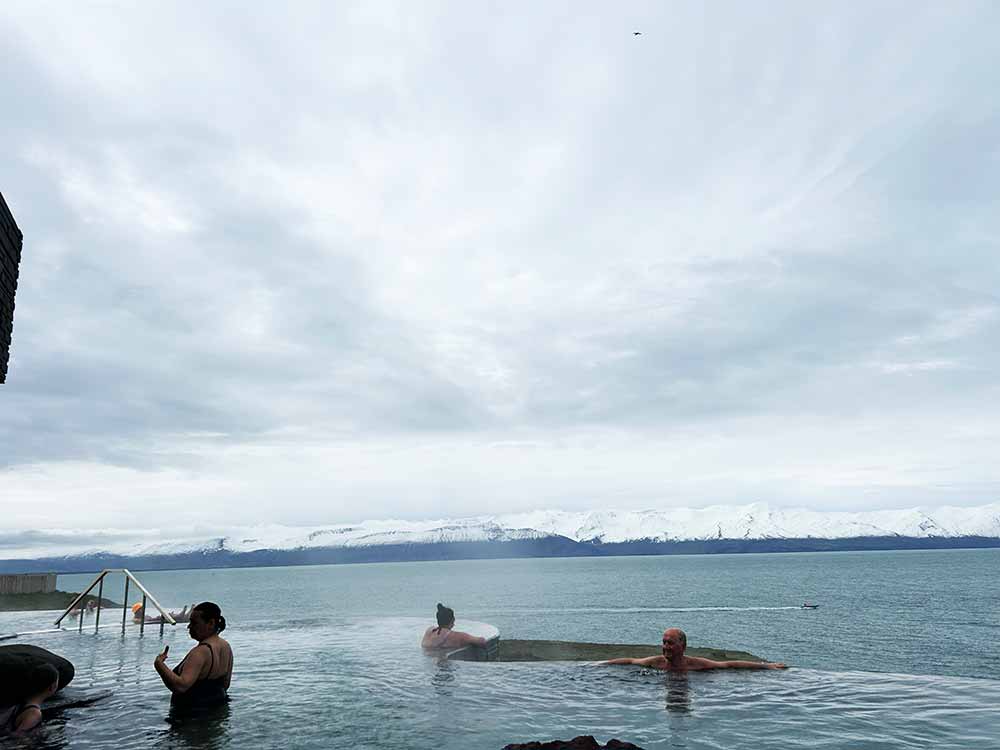
Photography courtesy of Grace Lee-Weitz | Hop Culture
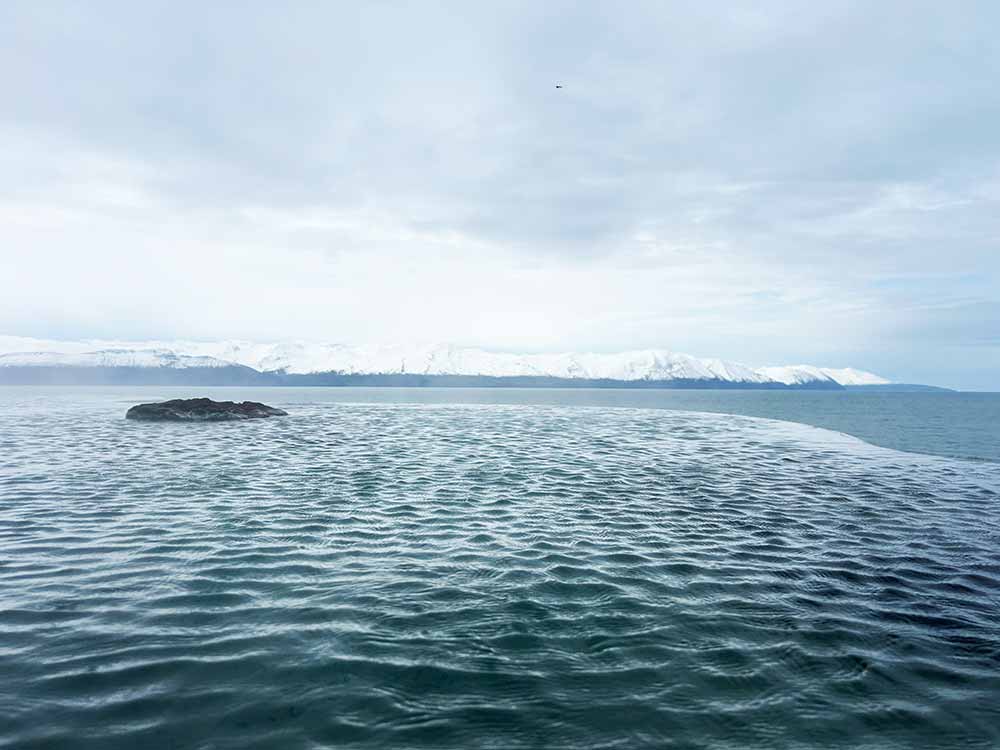
Photography courtesy of Grace Lee-Weitz | Hop Culture
GeoSea Geothermal Sea Baths were quite possibly the coolest (or hottest) thing we did in Húsavík.
The series of infinity pools, heated entirely naturally from geothermal activity, looked out over the breathtaking bay and surrounding mountain range.
Watching the whale boats bounce up and down, like a toddler shaking a fishbowl, from the comfort of the heated seawater baths assured us we made the right decision to skip whale watching.
However, that didn’t stop us from straining our eyes wherever a boat stopped to see if a whale might leap out of the water, Free Willy style. Spoiler alert: They don’t do that in real life, at least not here.
Hit the swim-up bar, where you can order beer or smoothies from a local company, like the Elvis, which, to an American, seemed odd, as it didn’t have peanut butter or bacon, but more sensibly vanilla milk, banana, and strawberries.
GeoSea gave us a relaxing way to unwind for a couple of hours and recharge our weary bodies for the travel day ahead.
Pro Tip: During peak times in the summer, time slots can sell out here, so book your visit ahead of time here.
Húsavík Öl
Heðinsbraut 4, 640 Húsavík, Iceland
In an old milk factory, you’ll find Húsavík’s most popular watering hole. Started by Þorsteinn Snævar Benediktsson (also known as Steini), who serves as the head brewer, Húsavík Öl is one of the more creative craft breweries in Iceland.
Steini plays around with styles here. For instance, when we visited, they had on not only a session IPA, West Coast IPA, and hazy, but also a saison and rice lager collab with Ægir Brugghús called RICEing Sun. Plus, a dark mild in cans.
On the night we visited, the taproom burst at the seams, with a bachelor party and friends just catching up. We snagged a booth and sipped on that rice lager well into the evening…when, thanks to the long summer days, the sun still appeared to be rising.
Pro Tip: Húsavík Öl has limited hours, so be sure to check their exact opening times in the summer.
Dining: Gamli Baukur
Hafnarstétt 9, 640 Húsavík, Iceland
A landmark in Húsavík’s harbor, Gamli Baukur is on the touristy side, but it’s actually quite good. The maritime theme reflects the restaurant’s location in the heart of Húsavík, and on a sunny day, you can enjoy lounging on the extensive patio, watching the swaying whale boats come and go.
Local ingredients anchor the pub menu here, which, *surprise, surprise,* leans nautical, with items like cured arctic char, fish soup, and grilled cod. But don’t sleep on salad; it was actually quite good!
Day Six: North Iceland: Árskógssandur
Bruggsmiðjan Kaldi
Öldugata 22, 621 Árskógssandur, Iceland
When we pull up to Bruggsmiðjan Kaldi, a short, stocky, red-haired man greets us boisterously. “Alright, guys, welcome to Kaldi. My name is Siggi,” he says energetically while introducing us to his sister, Esther, and mom, Agnes, whom he calls the “big boss.”
Started by Siggi’s parents almost two decades ago, Bruggsmiðjan Kaldi is a “family business,” as he tells us.
But Kaldi is more than just a collection of family members. In what seems like the middle of nowhere, in a place 250 miles (402 km) from Iceland’s capital, this building became the first-ever craft brewery in Iceland.
Interestingly enough, much like KHB, this brewery also has Czech roots.
Before we meet more of Siggi’s family, he steers us to the bar. “Could I start you off with some beer?” he says proudly.
Swiftly grabbing a glass, he pours us each some clear, amber-gold liquid. “This is the first beer we brought to market,” explains Siggi, who learned the recipe from Kaldi’s first brewmaster, David Masa, when he turned sixteen.
Siggi moves and speaks with purpose. Kitted out in a bright blue vintage Errea Iceland national men’s soccer team jersey, Kaldi’s brewmaster moves like he’s playing, darting confidently from one thing to the next.
As he sets down the branded tulip glass in front of us, he explains that the beer called Ljos means “light” in Icelandic.
The Czech pilsner has a pleasant maltiness that borders on nuttiness, which Siggi attributes to the single decoction process (a method of drawing off a set volume of malt from the mash and boiling the cracked grains). “It brings out more Maillard reaction, the caramelization into the beer,” he tells us.
This is the beer Siggi trots out first, like his prized fighter. When a couple walks in randomly during our visit, they ask Siggi about his favorite. He responds without hesitation, “I always like to start people with our Czech Pilsner.”
Czech influence runs deep at Kaldi, whose brewhouse was built in Czechia by Paul Holborn, an American brewing pioneer who designs brewing systems for breweries around the world. “He built this system for us to do decoction mashing,” says Siggi, pointing one fully tatted arm behind him to the gorgeous, gleaming copper brew kit.
Without a doubt, this is the focal point of the brewery, almost like a shining lighthouse in the vast starkness of the Icelandic landscape.
Much like Kaldi itself, which calls a tiny village on one of the longest fjords in Iceland home; it’s really just a cluster of houses, a ferry port, and one brewery.
But water is life at Kaldi.
Born and raised in the area, Kaldi Co-Founder Agnes Anna Sigurðardóttir grew up in a fishing family.
Siggi’s father moved to the area when he was sixteen to work as a fisherman. He spent twenty-seven years fishing until a bad accident in the spring of 2003 ruined his left knee.
“If you lose a leg,” says Siggi, “you can’t work at sea.”
Pivoting, Agnes suggested the couple start a brewery after watching a TV story covering the popularity of microbreweries in Europe.
Agnes explains in Icelandic that her grandmother taught her to “always respect that privilege to have good water,” Siggi translates.
With beer made up mostly of water, starting a brewery made sense.
After trips to Denmark and Czechia, Agnes and her husband opened Kaldi in 2006.
They put everything on the line, including their house, their parents’ houses, and their car, just to finance the business. “Everything was under for the business,” says Siggi.
It’s why Siggi’s brother, Þorsteinn Hafberg (called Steini), came up with the name Kaldi.
Although it has several meanings, including cold in Icelandic and to reference a special forecast for weather out at sea (a slight nod to the family’s fishing history), Kaldi is part of a saying in Iceland that means, “you’re doing something stupid but brave at the same time,” says Siggi.
Beer here isn’t just liquid in a glass; it’s a story of one family.
Kaldi follows the Reinheitsgebot (German Purity Law), which states that beer can only be brewed with four ingredients: water, barley, hops, and yeast.
All but two of Kaldi’s beers follow these regulations. “That’s a big deal for us,” says Siggi.
All of their two-row floor-malted barley comes from Raven Trading in Olomouc, Czechia.
Kaldi offers six year-round beers: Kaldi Ljós (Czech Pilsner), Kaldi Dökkur (Dunkel/Dark Pilsner), Kaldi IPA, Kaldi Lite, Kaldi Neipa (New England IPA), Kaldi Belgískur Tripel, and Kaldi 0,0% (NA beer).
But don’t sleep on Siggi’s seasonals, including Agnes’ favorite, a winter seasonal called Þorra Kaldi, a 5.6% ABV hoppy lager enjoyed during Þorri, the coldest months of the year, January to March. Þorri is the season when Icelandic people gather at festivals to eat traditional foods (such as fermented shark, sour whale, and ram testicles) and drink a variety of alcoholic beverages.
And for the love of Pete, if Siggi is pouring a barleywine, try it, right after the Ljos Czech pilsner, of course.
Activity: Bjórböðin Beer Baths
Despite being in the middle of nowhere, Agnes tells us that Kaldi receives between 15,000 and 18,000 visitors a year.
They come not only for the beer but for the Bjórböðin Beer Baths.
Unsurprisingly, the family’s entrepreneurial matriarch came up with this idea as well, after visiting a beer spa during one of her trips to Czechia.
“She said she’d never felt her skin, her hair [feel so good],” explains Siggi. “She wanted to open up the first beer spa in the Nordic countries.”
Siggi bought the building that now houses the beer spa when he was nineteen, planning to build his own house on the property.
But when Agnes came up with the idea, he built a beer spa instead. “With the help from a lot of good people,” he assures me.
An entire experience, the Beer Spa includes a dip in what they call “hot pots,” or hot tubs overlooking the fjord.
We’re lucky, the manager of the Beer Spa tells us, as we gazed at perfectly white-capped peaks. The fresh snow came down just a couple of days earlier. If we’d been here last week, we’d be looking at dirty mountain tops.
The main show, however, is inside. The manager shows us each to a private tub filled with young lager, the Kaldi Ljos that hasn’t fermented for as long as the one we drank hours earlier.
Next to each tub is a private tap, giving you unlimited self-pours of Kaldi’s Czech pilsner.
“This is your day to relax,” the attendant tells us as we slip into that warm mixture of young lager, hops, yeast, and bath products.
Amongst the aroma of freshly baked bread and lavender soap, we soak and sip, emerging from the tubs fresher, cleaner, and definitely a little less sober.
Pro Tip: You can eat lunch in the restaurant connected next door, which, of course, serves Kaldi beer, too. The flatbreads are *chef’s kiss.*
Dining: Eyri Restaurant
Hjalteyrarvegur, 604 Hjalteyri, Iceland
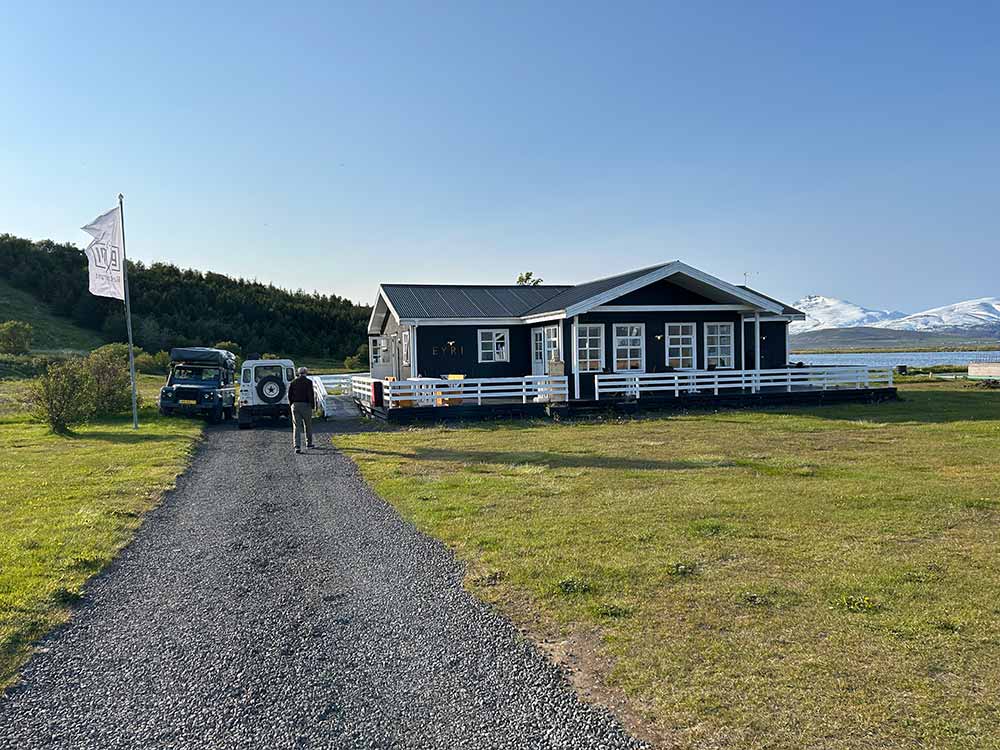
Photography courtesy of Grace Lee-Weitz | Hop Culture
The attendant at Bjórböðin Beer Baths recommended this place to us. Somewhat of a hidden gem, Eyri is located in an old fishing village called Hjalteyri, a fifteen-minute drive from Kaldi.
Using locally sourced ingredients, Eyri focuses on Icelandic cuisine with some modern twists.
Located in what looks like a house sitting right on the fjord, Eyri feels like a log cabin with its animal rugs plastered to the wall.
Although fish- and meat-heavy—expect a fish of the day served with Icelandic roast potatoes and organic vegetables over smoked sweet potato puree and reindeer in some preparation—Eyri always serves a vegan option called “Vegan dish of the day.”
If you’re feeling frisky, opt for the three-course tasting menu, which includes any starter, main course, and dessert for about eighty bucks (9,900 Icelandic Kronar).
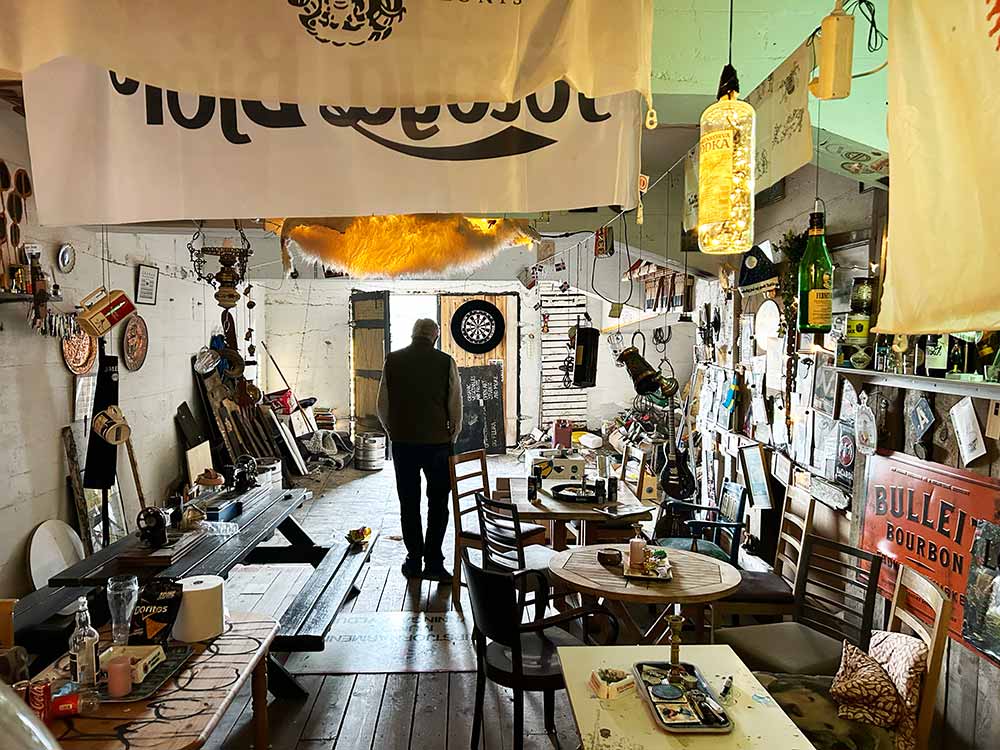
Photography courtesy of Grace Lee-Weitz | Hop Culture
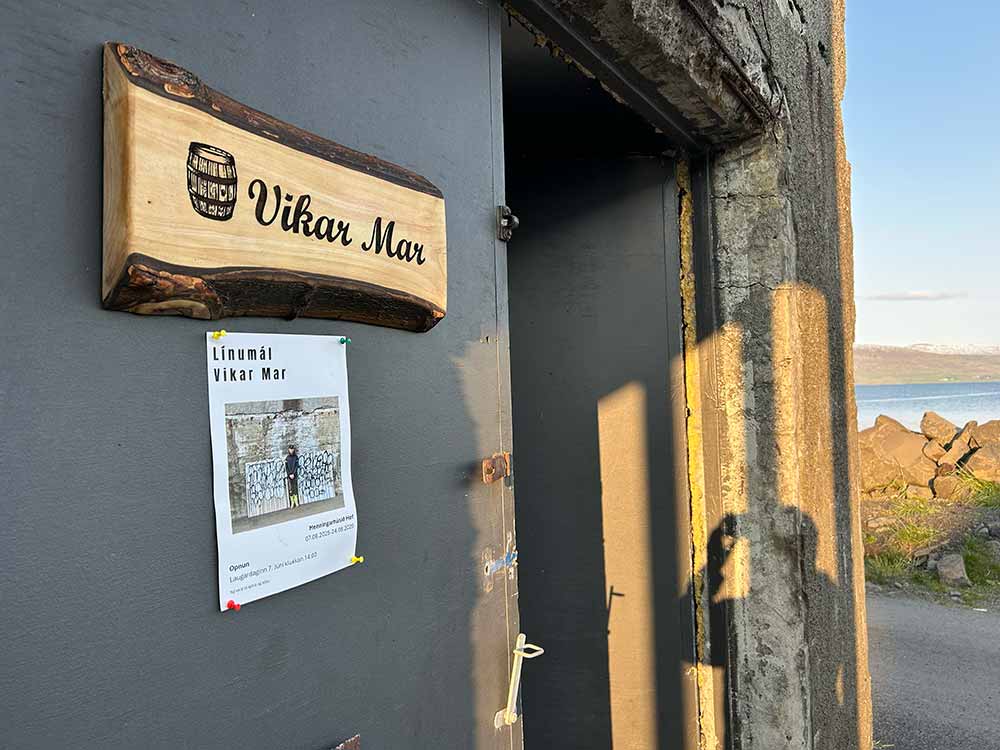
Photography courtesy of Grace Lee-Weitz | Hop Culture
Pro Tip: After dinner, take a stroll past the pier. Walk by the Hjalteyri Hot Tubs and the town’s only convenience store. Hopefully, you’ll find a slate grey door propped ajar. We received a tip about this place, Hjalteryri’s not-so-hidden locals bar. It’s run on an honor system, so go inside, grab a can from the fridge, or pour yourself a beer from the taps into a plastic cup (if they’re working). Then just leave whatever you feel is appropriate in the tip box. The inside is quite like a hoarder’s paradise, crammed with tin tackers, vodka bottles turned into lights, candelabras, and a random bust of a woman (?).-
Stay: Hotel Kaldi
Árskógssandur IS, Sjávagata, 621 Litli, Iceland
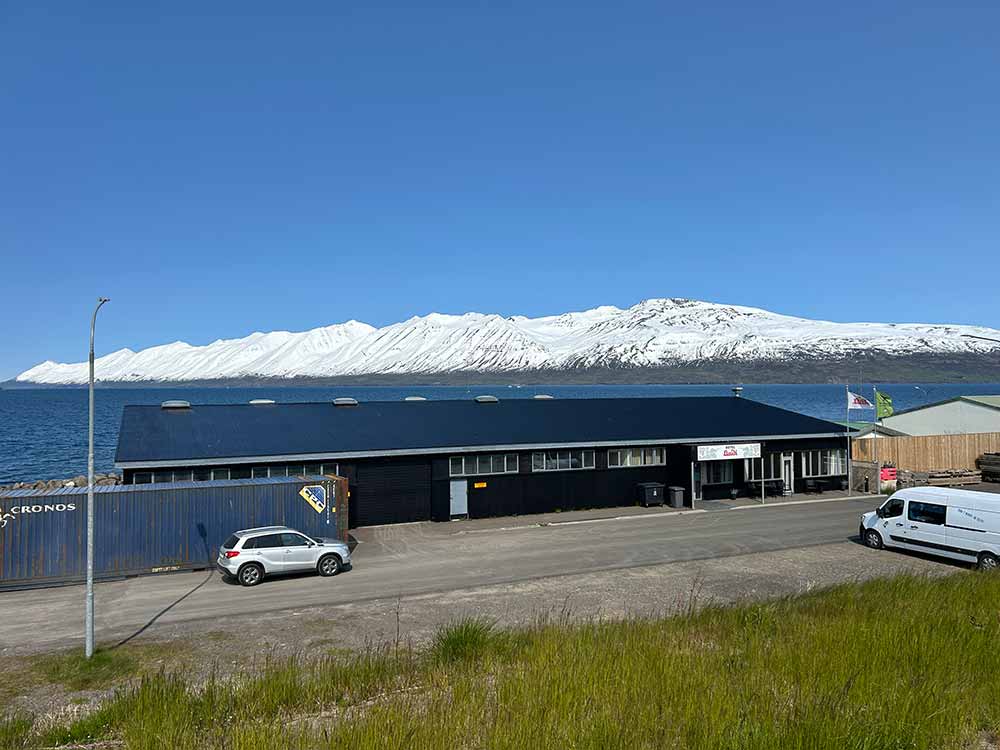
Photography courtesy of Grace Lee-Weitz | Hop Culture
Did you know that Kaldi the brewery also operates an eponymous hotel? Right behind the brewery, you’ll find a long, low building. Like many things around these parts, it’s sort of a serve-yourself operation. Open after 3 p.m., we walked in and checked ourselves in by just inputting a code sent through email on each room’s keypad.
Each room has Kaldi-branded glasses and bath products from the nearby beer spa.
This was one of my favorite places we stayed the entire trip.
Day Seven: North Iceland: Siglufjörður, Hólar, and Sauðárkrókur
Activity: Herring Era Museum & Róaldsbrakki Salting Station
Snorragata 10, 580 Siglufjörður, Iceland
Iceland’s largest maritime museum and winner of the European Museum Award, the Herring Era Museum captures what was once a crucial industry for the town of Siglufjörður.
Opened in 1994 in an old salting station, the museum’s exhibits spread over three buildings, interactively taking you through what life was like during the heyday of herring fisheries in Iceland.
It’s a pretty cool little museum and a great way to understand the cultural importance of this town’s biggest money maker for many years.
Segull 67 Brugghús
Vetrarbraut 8, 580 Siglufjörður, Iceland
Make no mistake, Segull 67 Brugghús in Siglufjörður doesn’t actually stand for seagull.
Translating to magnet in English, Segull is a nod to directions. “We are a compass always turning north no matter where you are,” explains Segull Owner Marteinn B. Haraldsson. “So, if you get lost somewhere, when you have a compass on you, you don’t have to worry.”
The “67” is somewhat of a lucky number in Marteinn’s family. His great-great-grandfather drove a truck in town with license plate number F67. His grandfather, a fisherman, owned a boat with the number SI67.
In the massive old fish processing factory, Segull 67 carries on the legacy.
Initially working in computer science in Akureyri, Marteinn, the homebrew hobbyist, moved back to Siglufjörður to pursue his passion.
“Basically, I tricked the family into investing with me,” he jokes. “I just gave them a beer and let them sign.”
The building that now houses Segull 67 sat empty for many years before Marteinn purchased and revived it. Today, the site includes Segull 67’s taproom, brewery, event space, and upstairs distillery, a new venture that focuses on incorporating Icelandic ingredients like Arctic thyme, mountain grasses, and Icelandic barley.
Beerwise, Segull 67 sticks to the classics, with four core offerings, including the best-selling amber lager, original pale lager, American IPA, and pale lager.
With each season, as we found pretty customary amongst Icelandic craft brewers, Segull 67 makes a Christmas, Easter, and summer seasonal (like a pineapple blonde ale).
When we visited, Marteinn even had a milk stout, Svarta María, that we tasted off the tanks.
This family-run brewery has become as crucial to Siglufjörður today as herring was in the past.
Bjórsetur Íslands (The Icelandic Beer Center)
551 Hólar, Iceland
This must be the smallest brewery in Iceland. In fact, Bjórsetur Íslands (aka the Icelandic Beer Center) is really just a slightly more refined homebrew setup in the basement of a building at Hólar University. The higher education institution is itself housed in an old cathedral in the town of Hólar, which is really just a cluster of University buildings. With only 250 students, 60 of whom live in the town, “this must be one of the smallest universities in the world,” quips beer author Tim Webb.
“Close to it,” agrees our guide for the afternoon, Professor Bjarni Kristjánsson.
More of a non-profit group than a business, the Icelandic Beer Center is run by Professor Bjarni, an evolutionary ecologist who admits he doesn’t teach much now, doing primarily administrative work, student supervision, and research.
Started in 2010, Bjórsetur Íslands “is one of the oldest of these smaller breweries,” explains Professor Bjarni as he proudly shows off his brew kit downstairs, which includes a Speidel Braumeister brewing device and a 50L Ss Brewtech fermenter.
Brewing without a set schedule and simply when he can, Professor Bjarni estimates he makes about 300 liters a year.
Handwritten stickers plaster the door, sporting names like Kuldi Cold IPA and Hóla Bjór Pale Ale.
“The idea is that we don’t have a lot of rules,” says Professor Bjarni. “We never do the same thing again.”
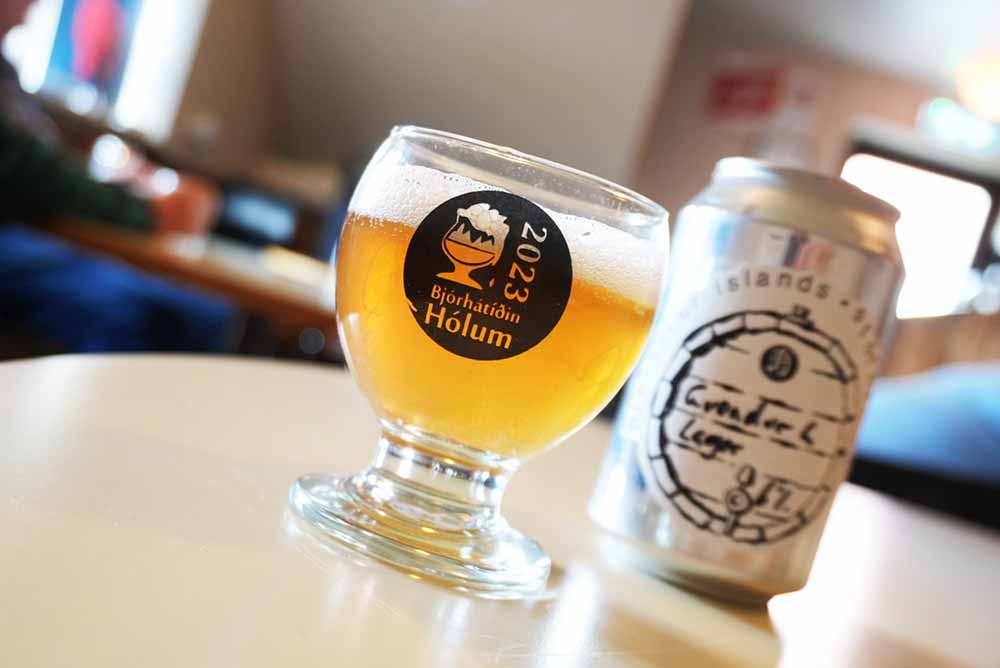
Photography courtesy of Grace Lee-Weitz | Hop Culture
For instance, he opens the upstairs pub every Friday, and then “when we feel like it,” says Professor Bjarni. “People come, stay, and have a couple of beers. … It’s the only place they can drink, really.”
Believe it or not, during our almost two hours in the upstairs pub, three different traveling couples poked their heads in, excited to see the pub actually open. They purchased beer to go.
We sipped on Gvendur G., a crushable lager. We chatted about the history of beer in Iceland. The professor and brewer, unsurprisingly, are full of knowledge.
Somehow, the hours peel away.
We can’t guarantee that Bjórsetur Íslands will be open when you visit. To increase your chances, visit on a Friday afternoon. But if you do make the ten-minute detour off Iceland’s Route 73, you may just be treated to your most historical and unique drinking experience in Iceland yet.
Dining: Jarlstofa Restaurant
Lindargata 3, 550 Sauðárkrókur, Iceland
We spent the night in Sauðárkrókur, a twenty-five-minute drive from Hólar. Full disclosure, there is not much to do or eat here. This was probably the least scenic stop on our trip. However, we did find a decent restaurant in the basement of Hotel Tindastóll.
Jarlstofa Restaurant leans Scandinavian and Icelandic with dishes like goulash, creamy salmon soup, Nordic bread with homemade cheese, reindeer meatballs, Nordic-style ribs, and fresh-caught Icelandic flatfish. There’s even a vegan dish, an eggplant steak with asparagus, sautéed chickpeas, and fermented tomato sauce.
Stay: Brim Guesthouse
Sæmundargata 15, 550 Sauðárkrókur, Iceland
We booked a guesthouse in Sauðárkrókur with an ocean view. Not too much to say here. This is a clean, modern, private place to lay your head at night.
Day Eight: Northwest Iceland: Hólmavík and Isafjörður
Galdur Brugghús
Norðurfjöru, 510 Hólmavík, Iceland
From Sauðárkrókur to Hólmavík, you take an incredibly scenic three-hour drive that hugs and wraps around multiple fjords.
Your destination: a magical brewery called Galdur Brugghús.
Walking inside transports you to a different time. Runes dot the walls along with mythical paintings and stories.
Opened in 2023, Galdur Brugghús is one of Iceland’s newer craft breweries. A collaboration between entrepreneurs Finnur Ólafsson and Aleksandar Kuzmanic, along with local residents and companies (eighty-two shareholders in total), Galdur plays heavily to the town’s history of witchcraft.
Galdur actually translates to magic in English. “This area is all about magic,” says Galdur Master Brewer Philipp Ewer.
Pro Tip: In Hólmavík, you’ll find the Museum of Icelandic Sorcery & Witchcraft in a tiny building just a stone’s throw from the brewery. There’s a little cafe inside too with a mean soup, so stop in for a little light lunch and browsing.
The German brewer moved to Iceland fifteen years ago. “I thought everything was more relaxed here,” says Philipp. “I got the possibility to make my own recipes.”
Like Vofa, an altbier that throws back to Philipp’s Dusseldorf roots.
Most beers touch on that magic theme.
For instance, the brewery’s best-selling Kukl, an amber-colored Vienna-style lager that’s “tested in sorcery in a calm and confident manner,” according to the brewery.
“Kukl is actually an Icelandic word for dabbling or playing around with magic,” Philipp explains.
Or Vetur, a jólabjór (yule beer) with “dark powers” thanks to the addition of pure licorice root, a typical Scandinavian sweet.
“I was quite scared to brew this beer the first time,” admits Philipp, worried about the overpowering flavors. “But you only get a bit [of the licorice] when you drink a whole glass. It brings out the malt a bit and makes everything smoother.”
With his whisky red handlebar mustache and long hair, Philipp himself seems like the wizard of Galdur.
Which, after you drink enough of his beer, you just might believe to be true.
Editor’s Note: When we visited, Philipp told us Galdur was currently only open Fridays and Saturdays, with the plan to be open every evening in the coming weeks. Make sure you check to see if they are open.
Dokkan Brugghús
Sindragata 14, 400 Isafjörður, Iceland
The most remote brewery in Iceland, Dokkan Brugghús, located in Isafjörður, is another three-ish hour drive from Hólmavík.
The first brewery in the West Fjords opened in October 2017 and believes the incredibly clear, low-mineral-content, high-alkaline water that trickles down from the mountains towering right outside its doors makes all the difference.
For instance, in the DYNJANDI IPA, which uses water purified by seeping through a fourteen-million-year-old volcanic lava pile, according to the brewery.
We really enjoyed the Djúpið, a red ale made with seaweed. We got a toasted rice exterior, similar to the slightly crunchy rice at the bottom of a Dolsot Bibimbap (known as nurungi in Korean) or a Spanish paella (called socarrat). We did get a slight salinity probably from the addition of dulse, but mostly this pleasantly malty, caramely liquid just felt like a pint for the soul after a six-hour day of driving.
Pretty sure we ordered two of these.
Dining: Tjöruhúsið
Neðstakaupstað, 400 Ísafjörður, Iceland
Just down the street from Dokkan is Tjöruhúsið, an incredible fish restaurant that serves you family style.
Book yourself for a seating; they usually do two a night at 6 p.m. and 8:30 p.m. Once at the restaurant, you’re presented with all of the dishes up at the front, buffet style. The order of business, after they serve you soup, is to get up, wait in line, and then feast on a variety of huge sizzling pans with different preparations of whatever they have freshly caught out of the ocean that day.
Vegetarian, like me?
No worries. There’s a myriad of side dishes, including seasoned potatoes, roasted cauliflower, pickled vegetables, grain salads, and much more. Plus, if you ask nicely, they’ll bring you an entire side plate of their house salad.
Editor’s Note: The restaurant advises that they do open sporadically, more so during the winter, so call ahead to make sure they’re open.
Stay: Apartment í Miðbænum
Pólgata, 400 Isafjörður, Iceland
Clean, simple, and very large, this was a great apartment for a one-night stay with three people.
Day Nine: Back to Reykjavik
Editor’s Note: While my two companions drove the six hours back to Reykjavik, I actually had an evening flight home to catch, so I took a tiny prop plane from Isafjörður airport. After a quick forty-minute ride, the flight dropped me off at Reykjavik Domestic Airport. Unlike Keflavík, this airport is a twenty-minute walk from downtown Reykjavik. Since I took a 9 a.m. flight from Isafjörður, I had a few hours to kill walking around Reykjavik. To get back to Keflavík, I booked a return shuttle from Flybus.
Ægir 101 Bar Taproom
Laugavegur 2 101, 101 Reykjavík, Iceland
Our last stop of the trip went back to where we started. You can’t leave Reykjavik without going to Ægir. While the brewery does have a taproom attached to its production facility on the outskirts of the city, it’s much easier to access the Ægir 101 Bar, right in the heart of Reykjavik.
You can’t miss the corner pub at the end of Reykjavik’s “rainbow street,” which is precisely what it sounds like—a pedestrian walkway with a giant red-orange-yellow-green-blue-purple mural running through the center.
Since it was just after noon, I opted for the Blíða, a 4.7% dry Irish stout. Ægir 101 has a back beer garden that overlooks the rainbow road, so we recommend taking your pint out there for a side of people watching.
You just never know who you might see or meet.
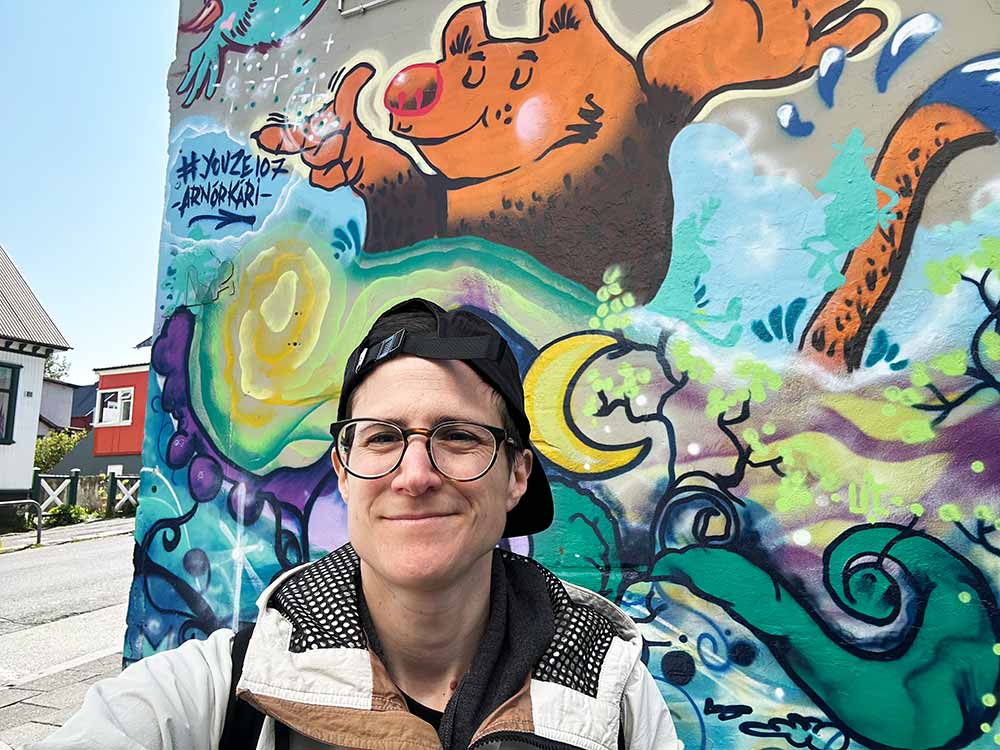
Hop Culture Director of Content in front of a mural by Icelandic street artist Kalli Youze | Photography courtesy of Grace Lee-Weitz | Hop Culture
We struck up a conversation with a guy who sat down and started a watercolor painting in his sketchbook. He turned out to be a street artist named Kalli Youze, whose murals we had just admired while strolling through Reykjavik.
Now, if you can think of a more perfect way to end our nine-day trip in Iceland, we’re listening.

